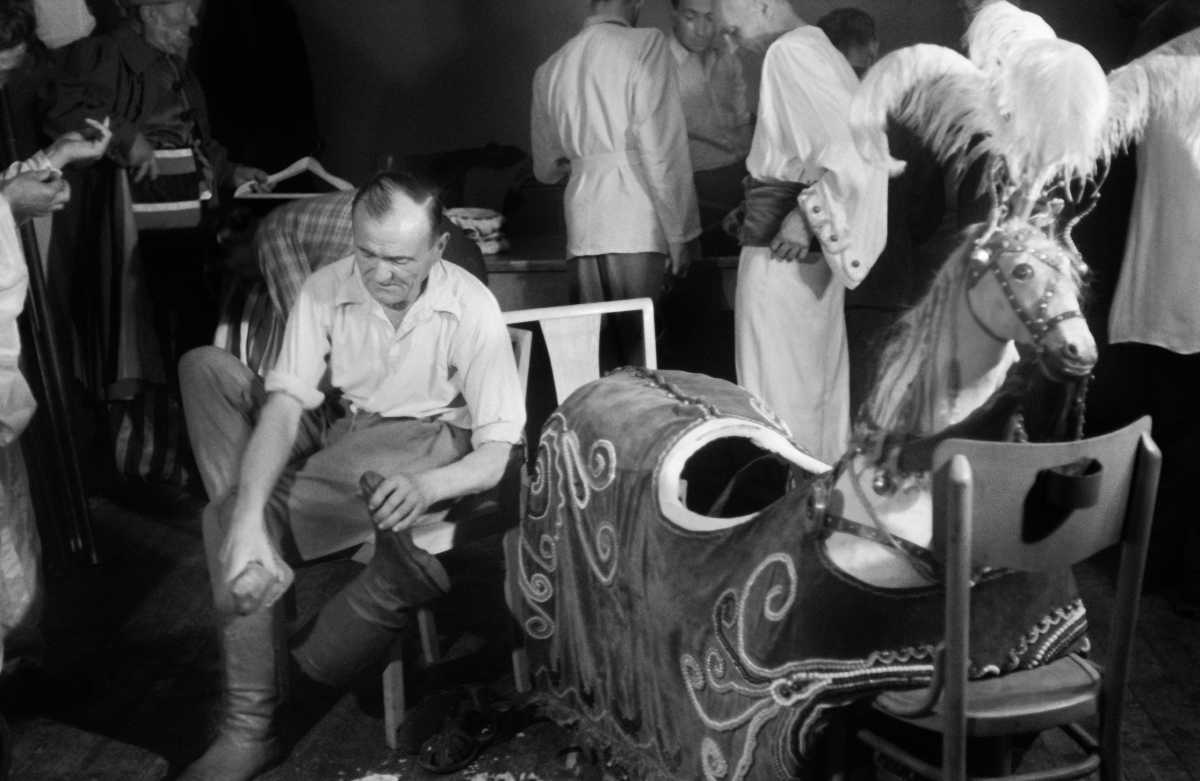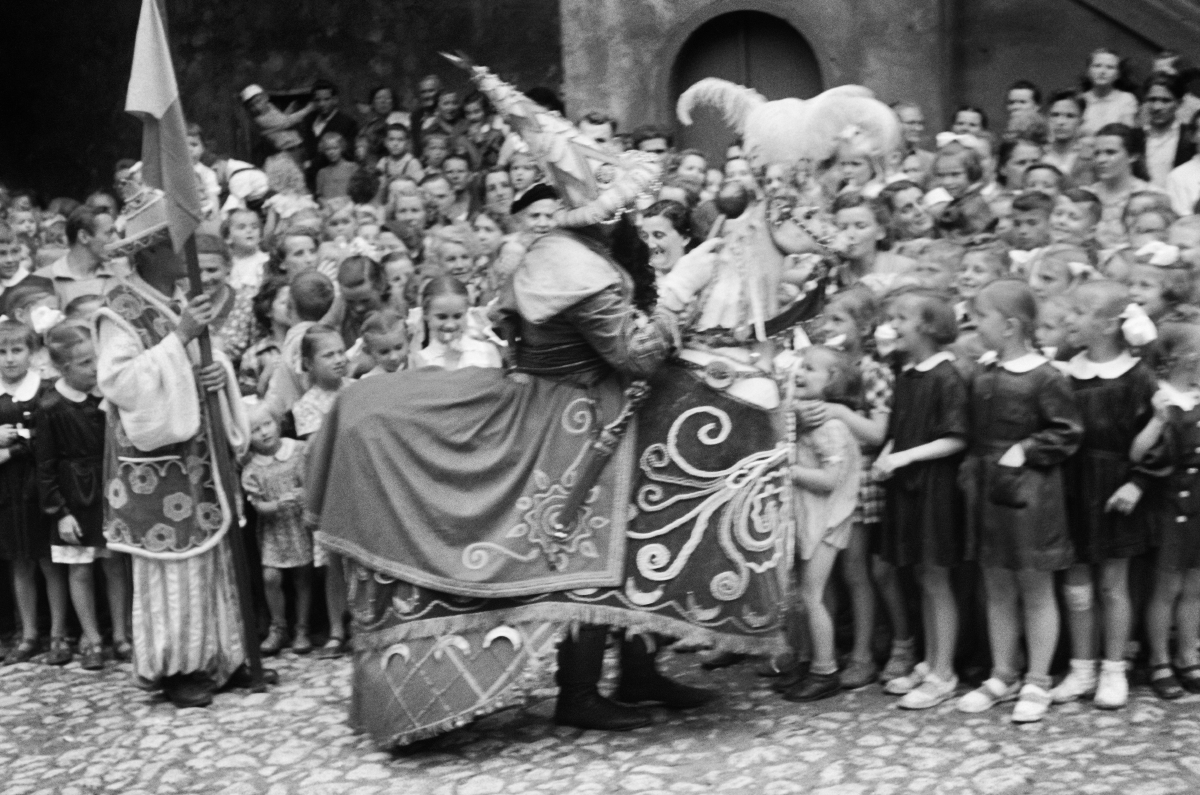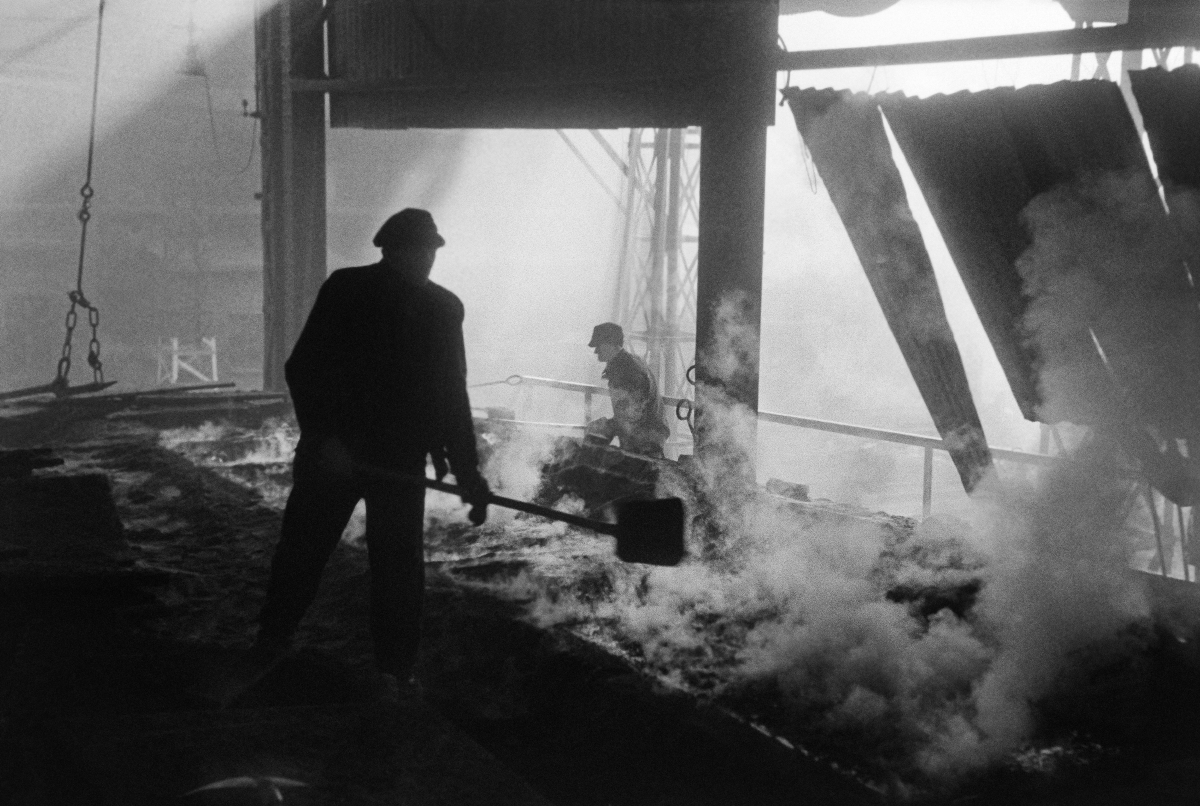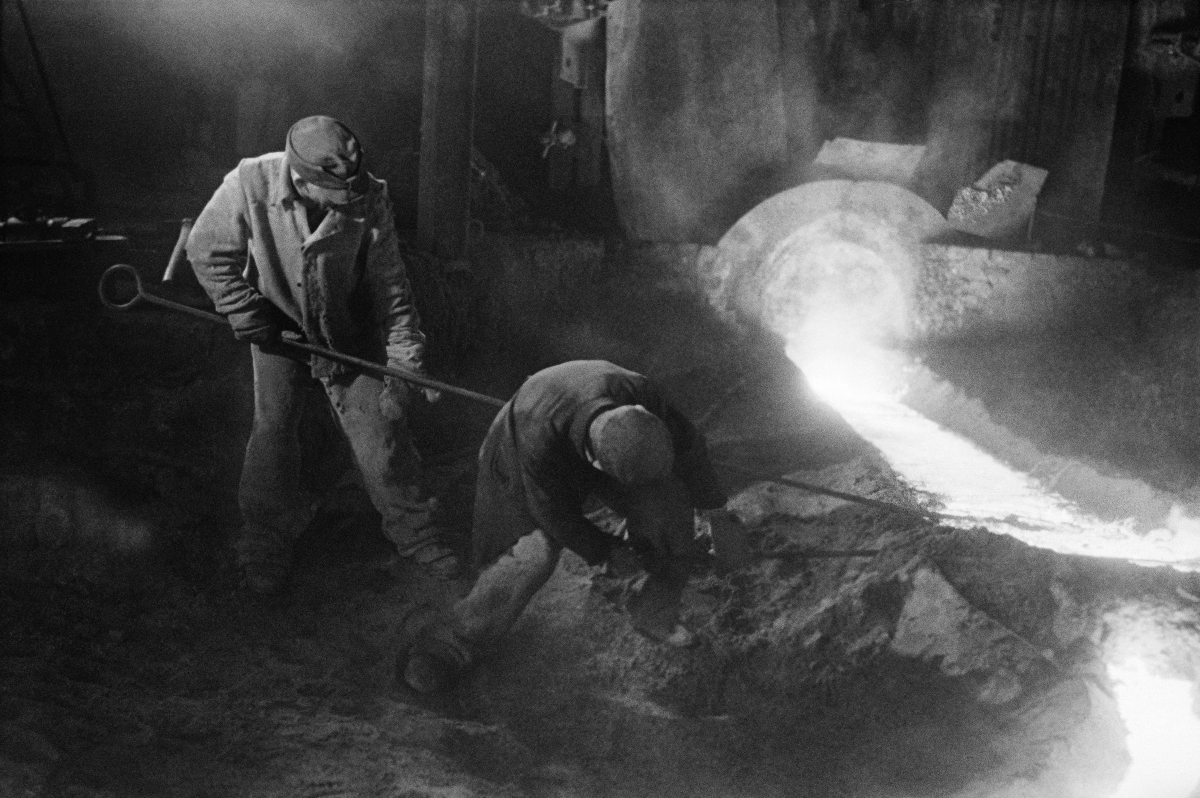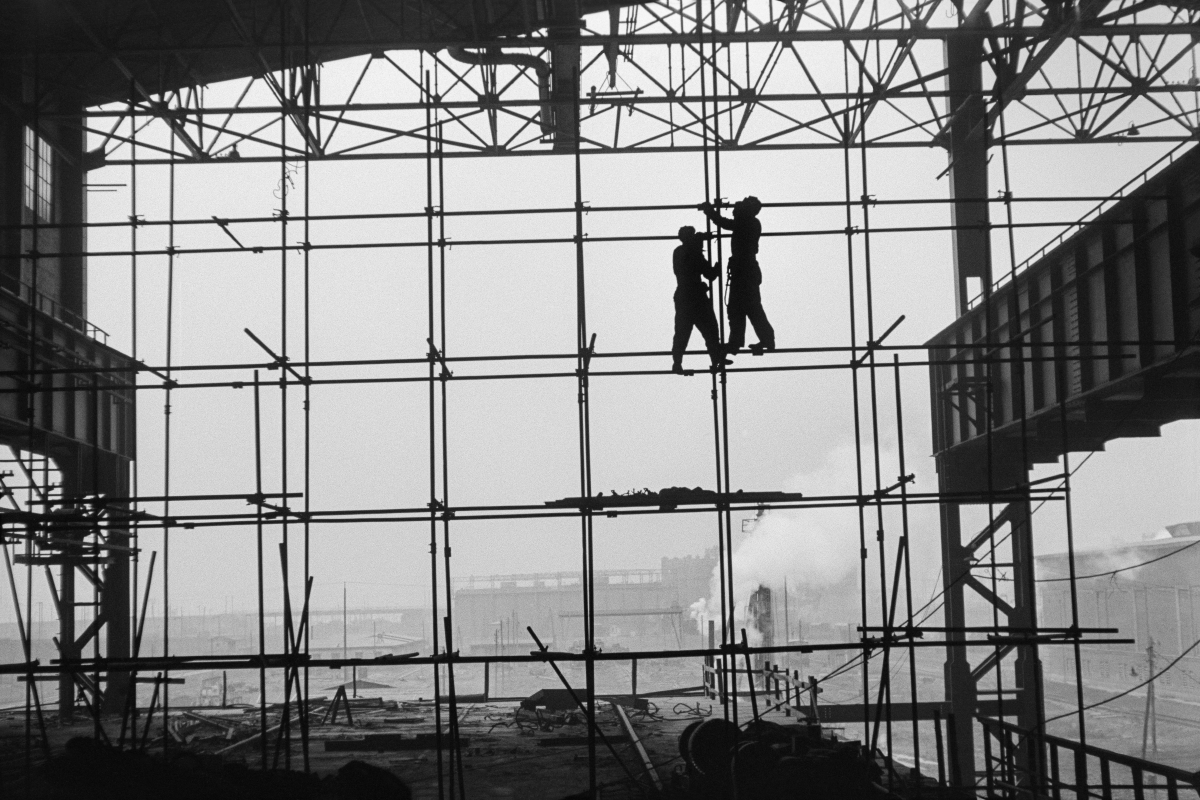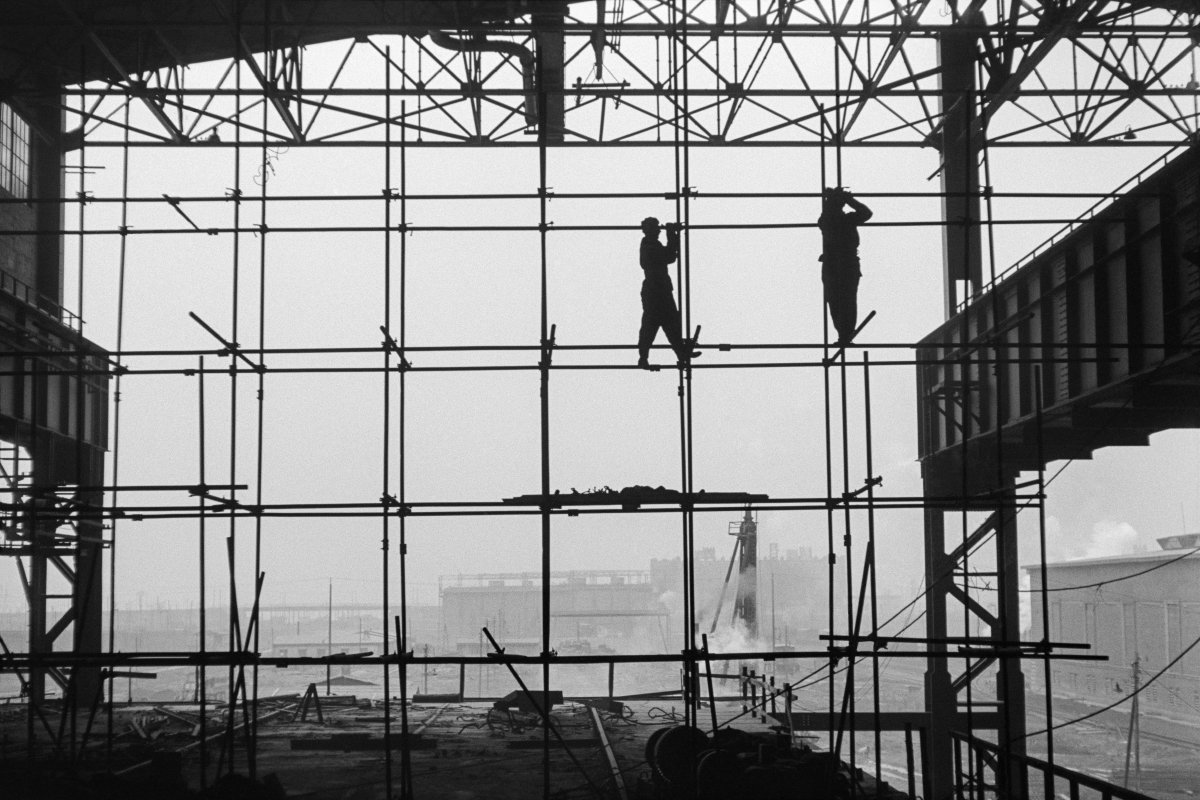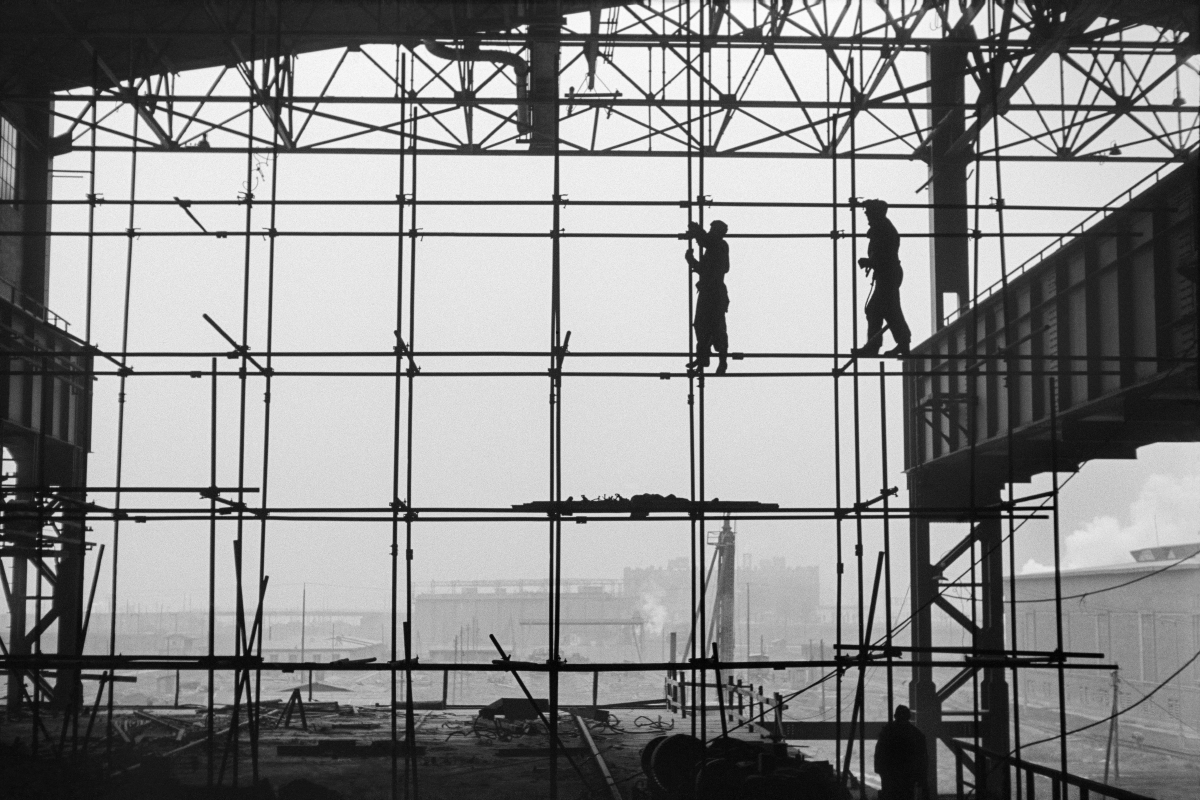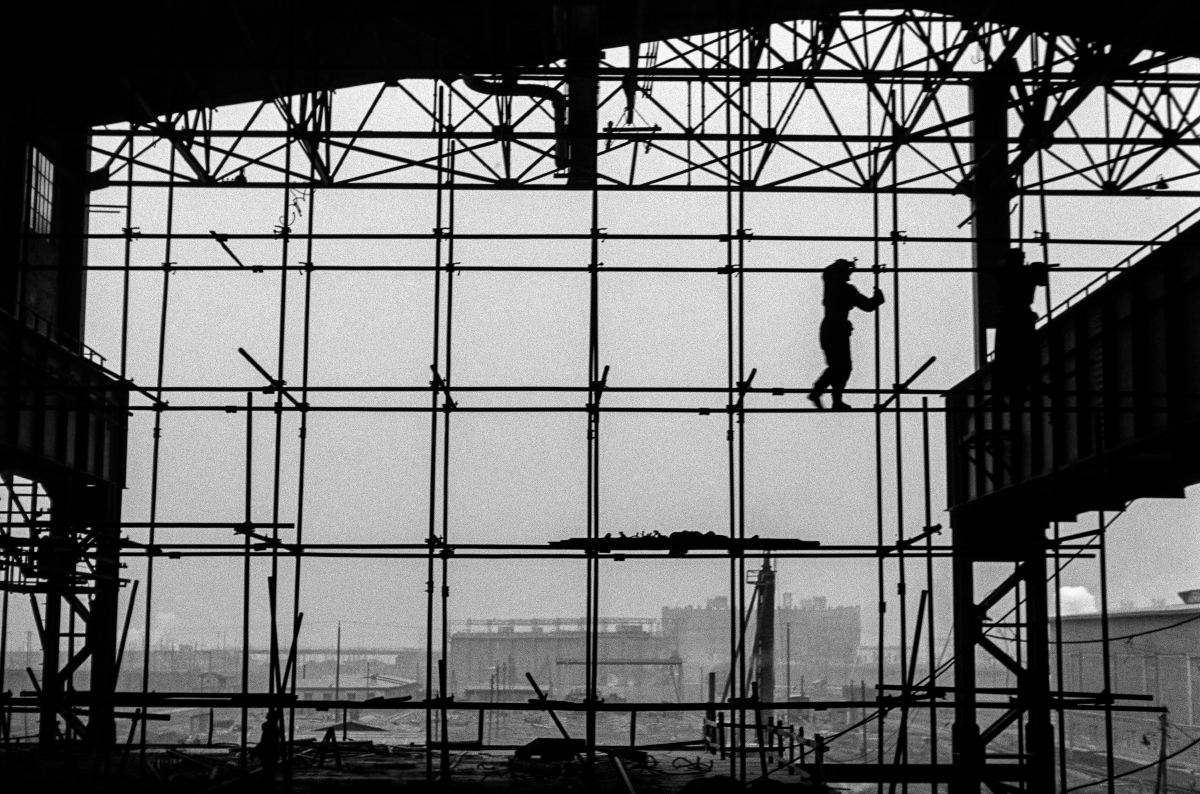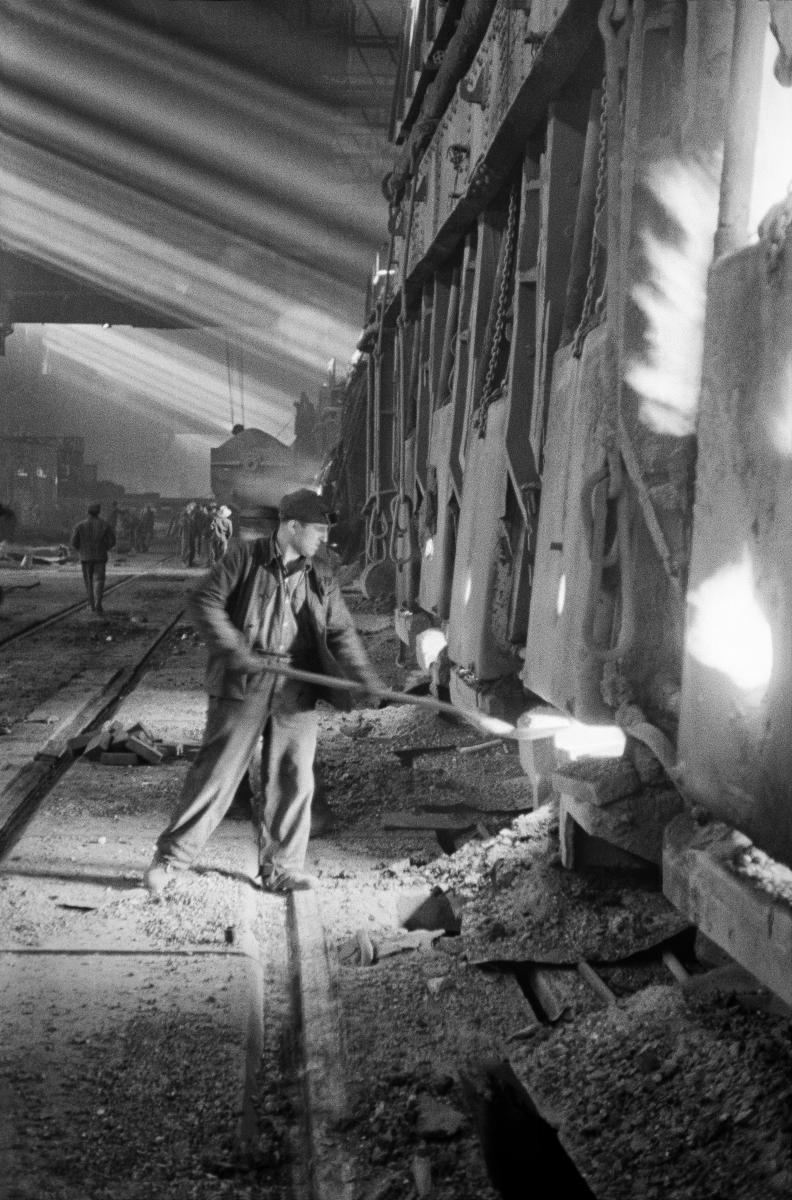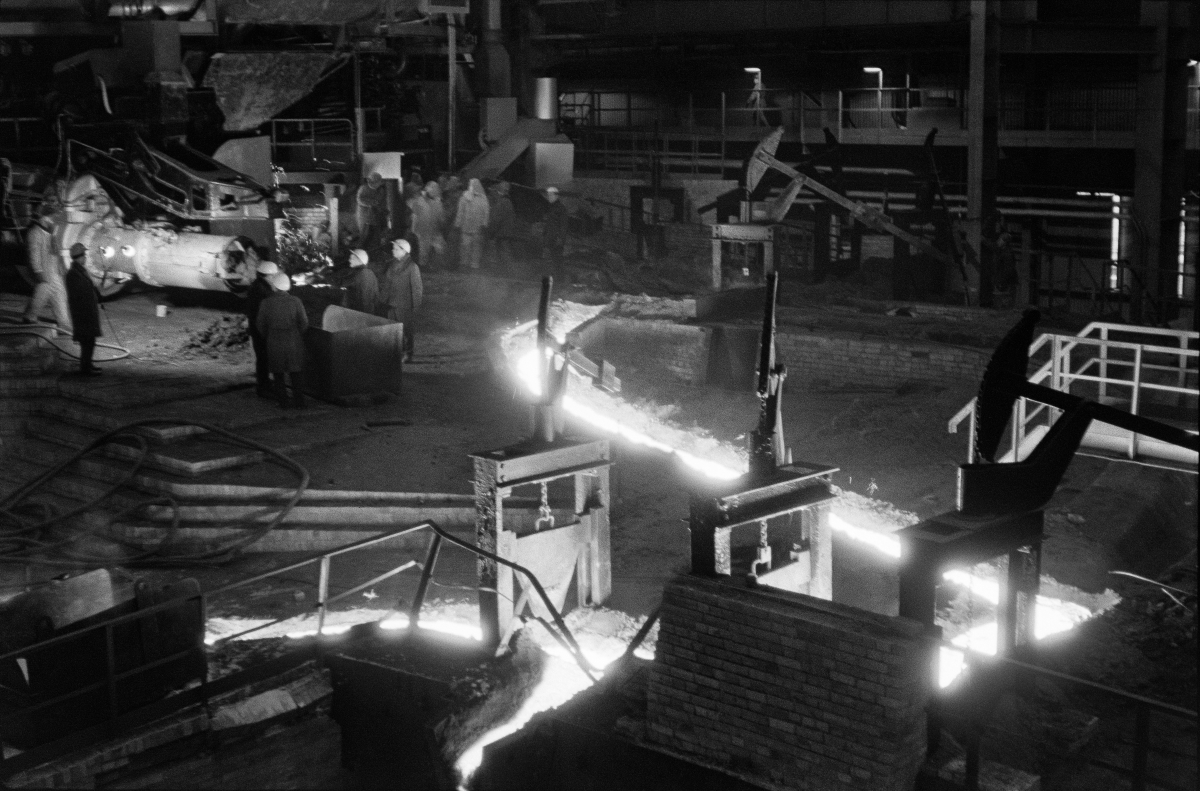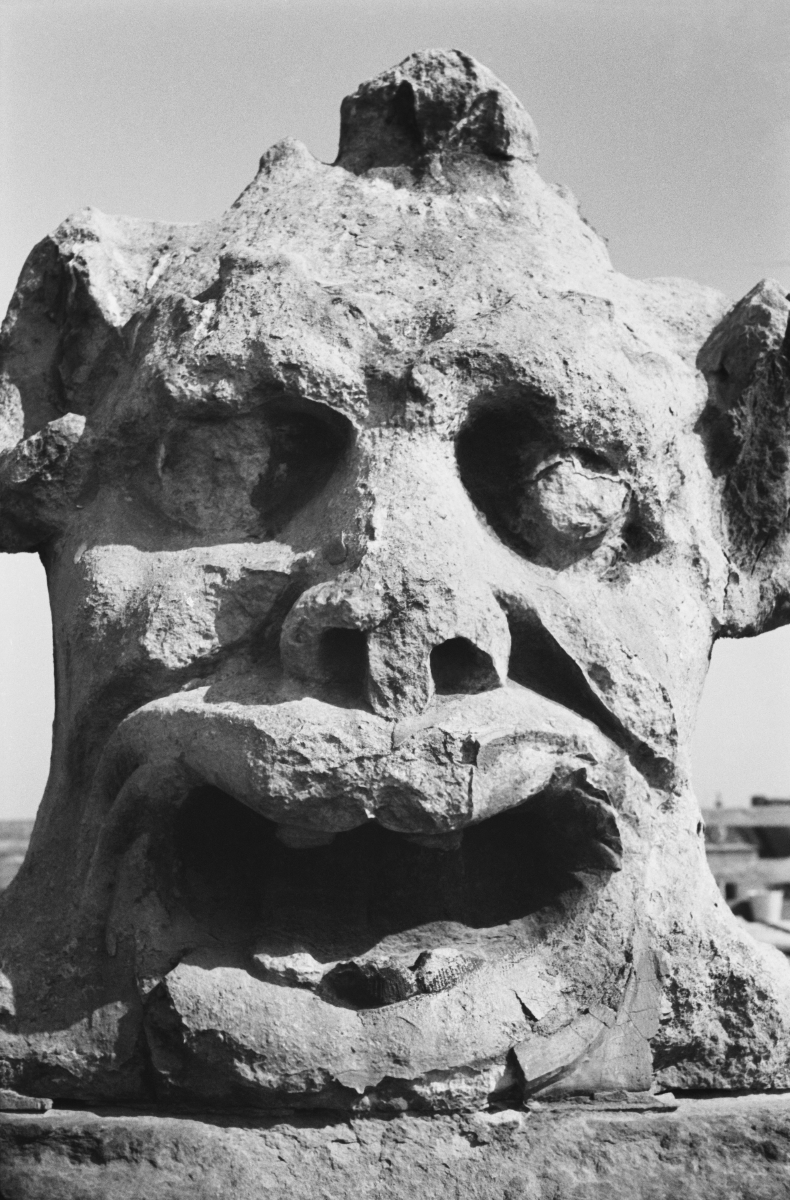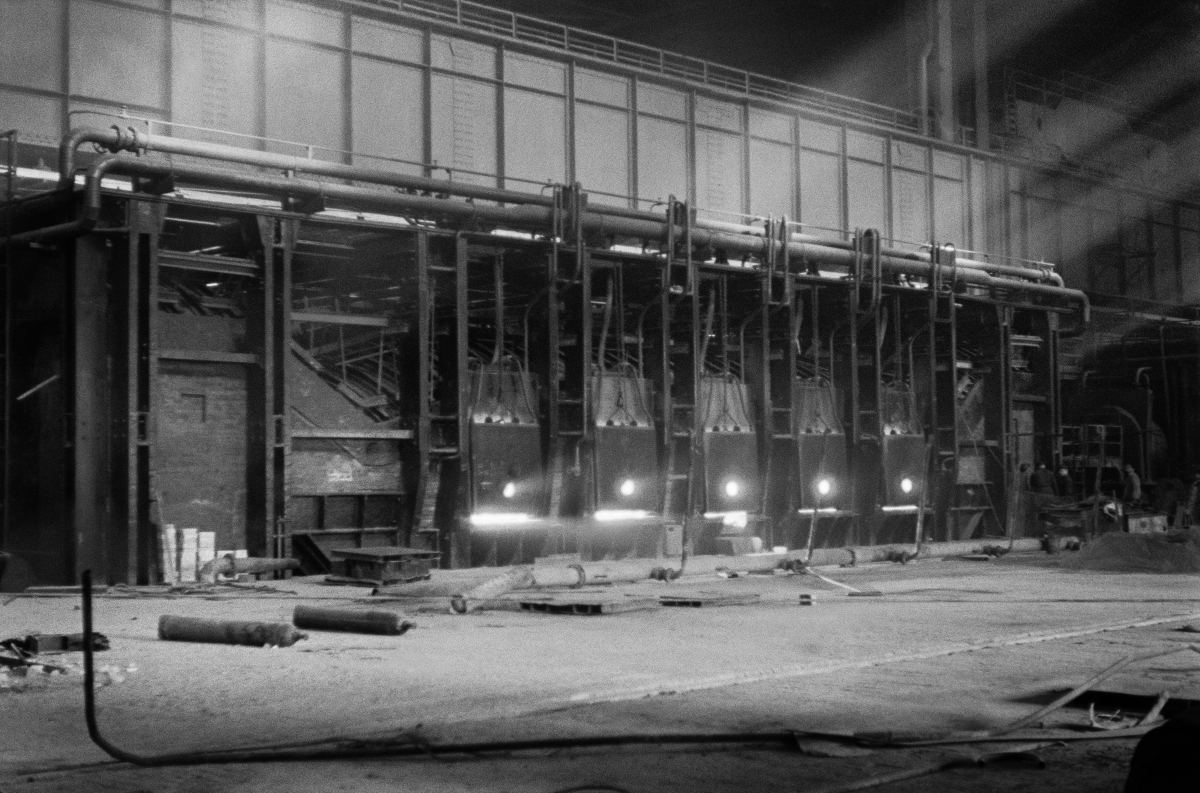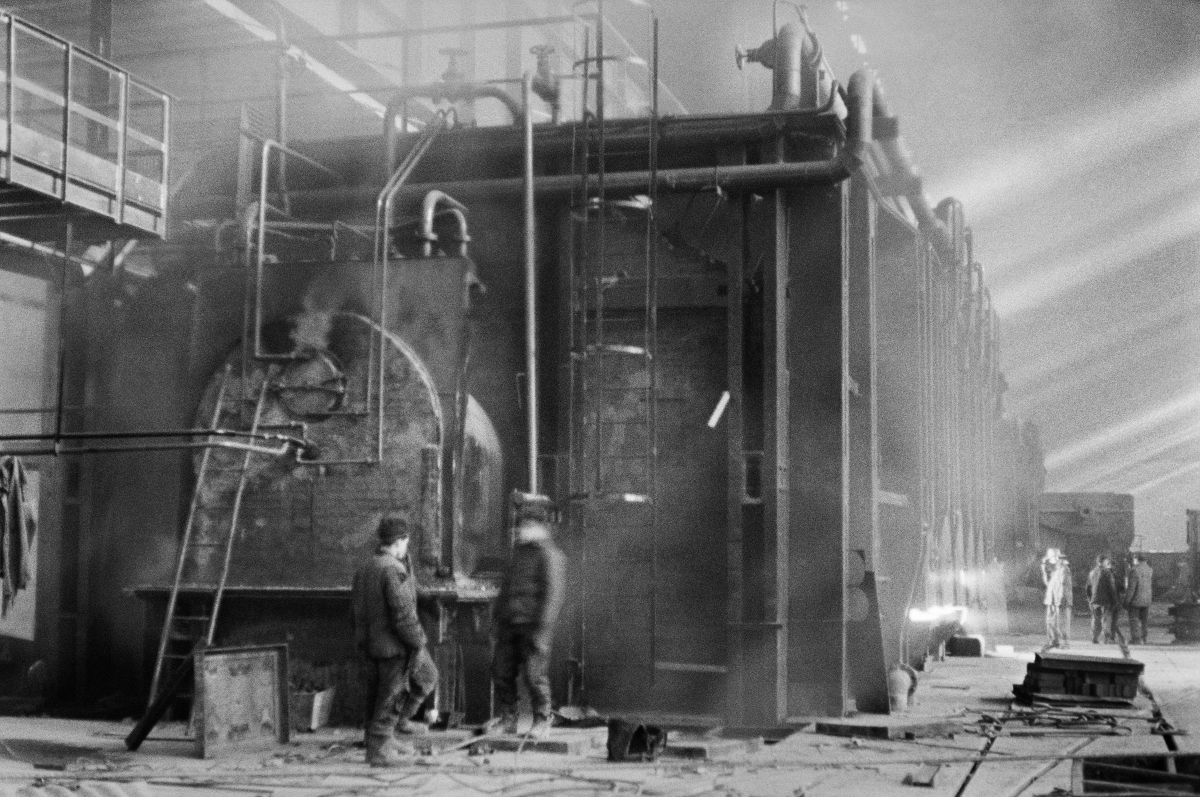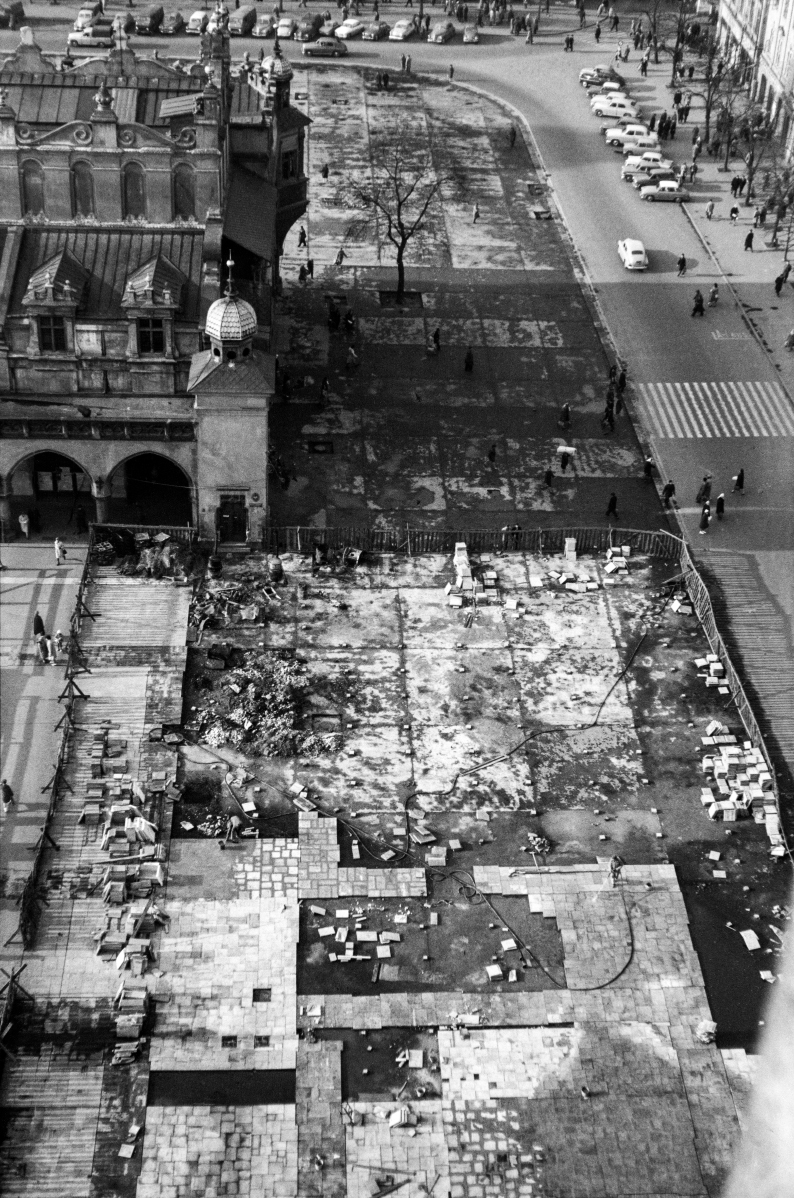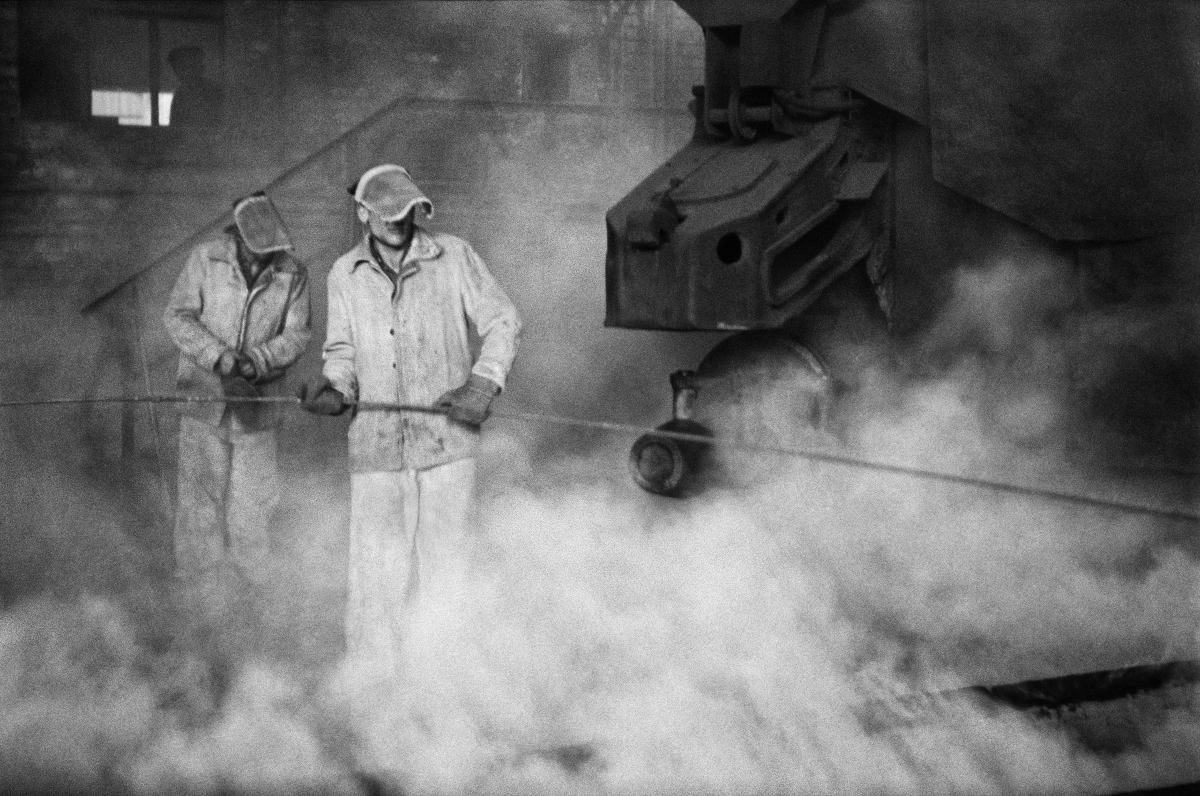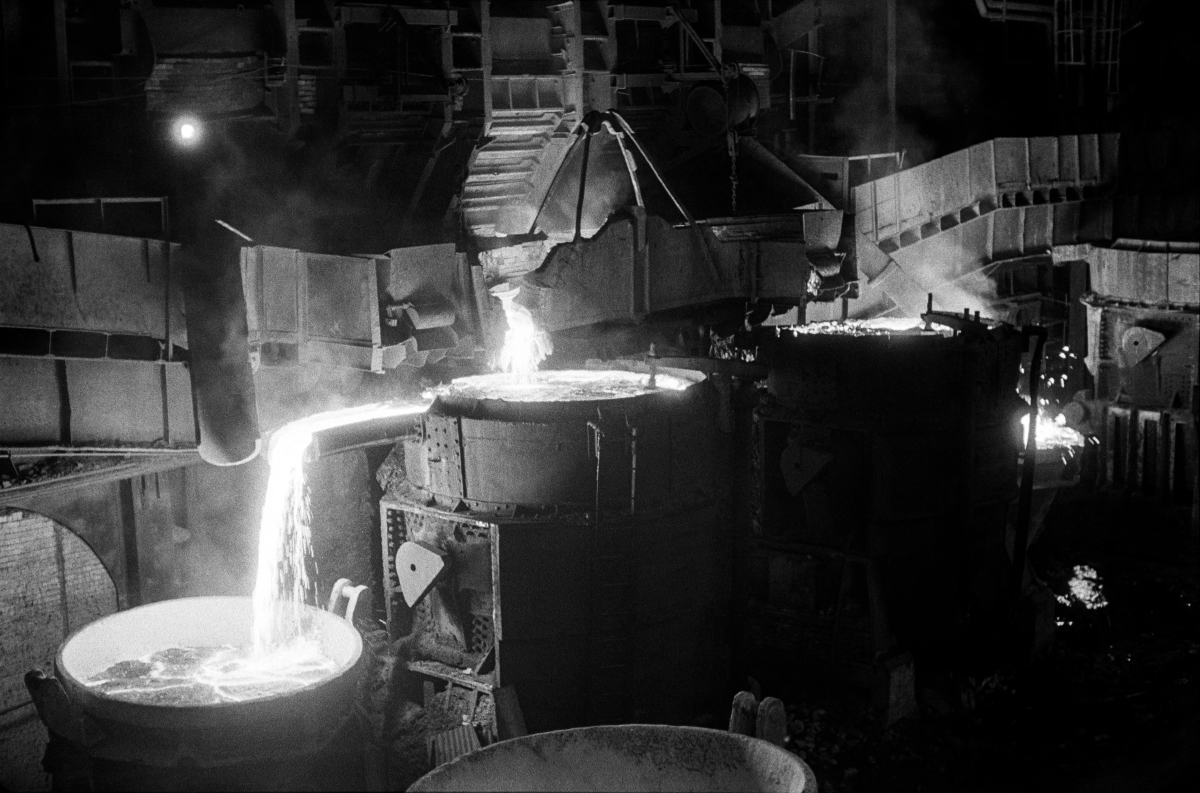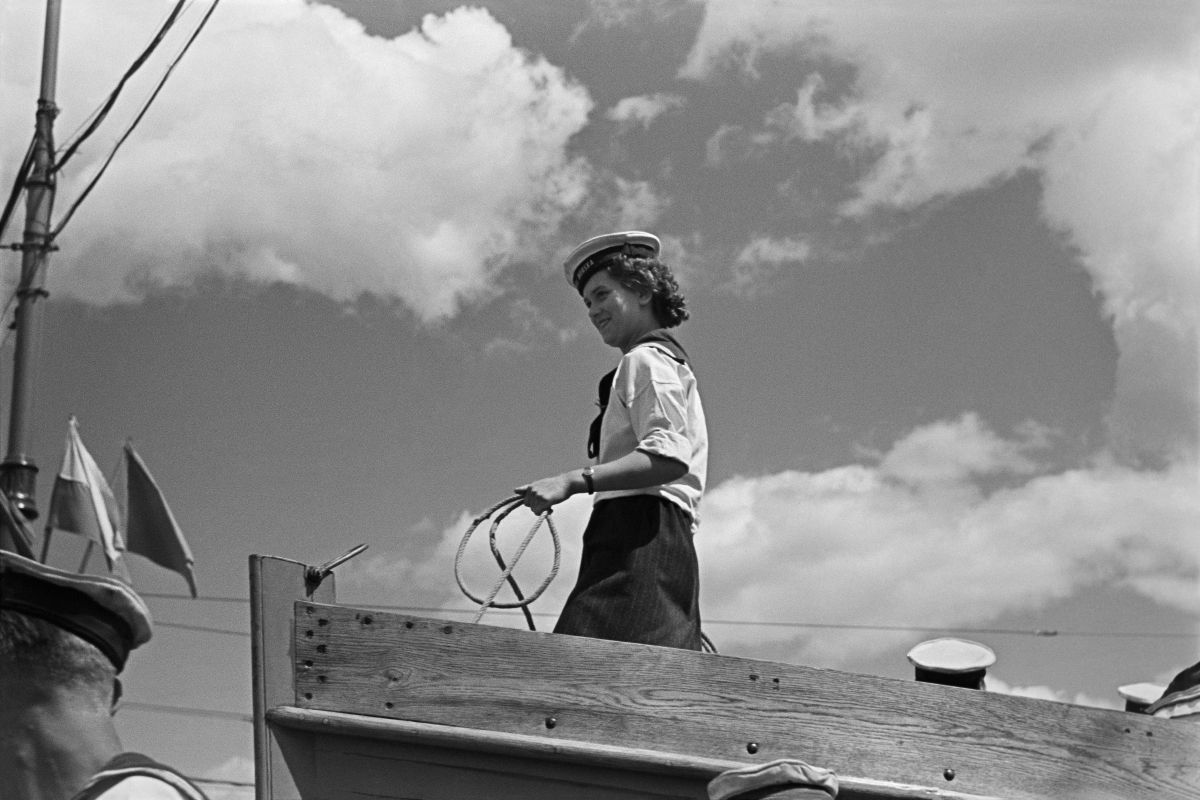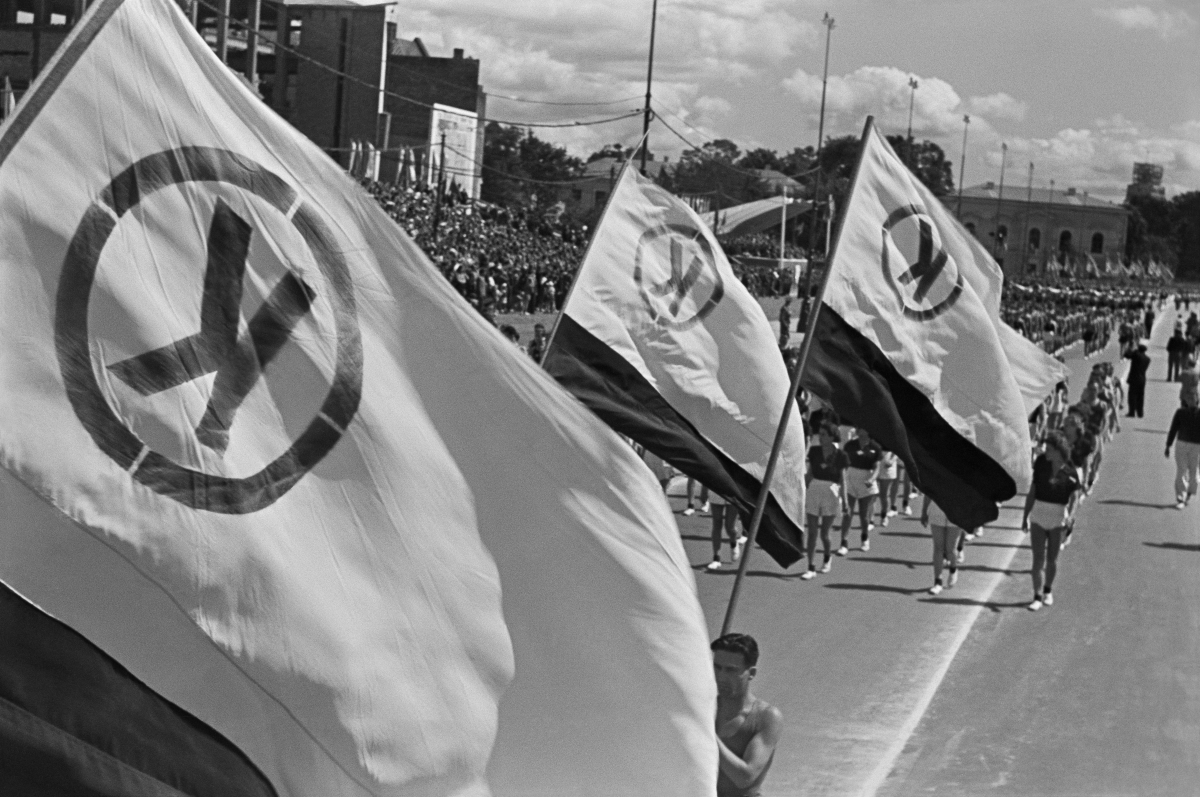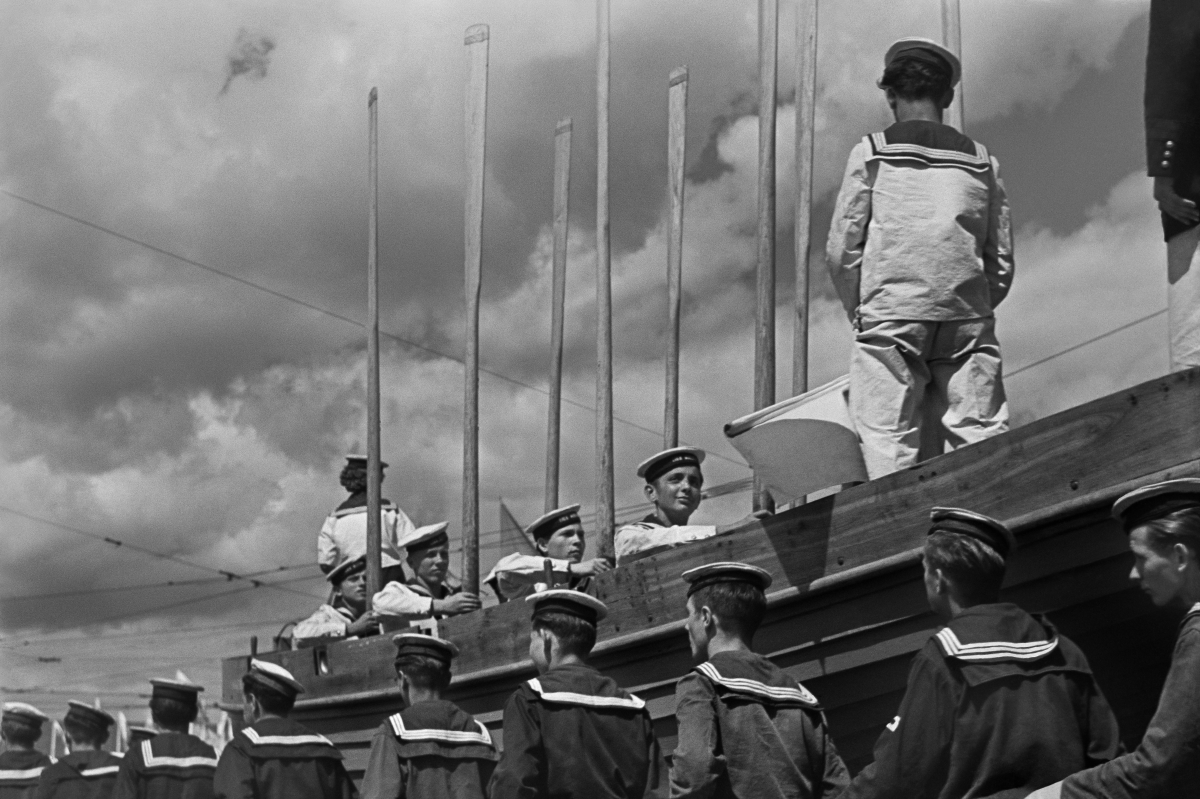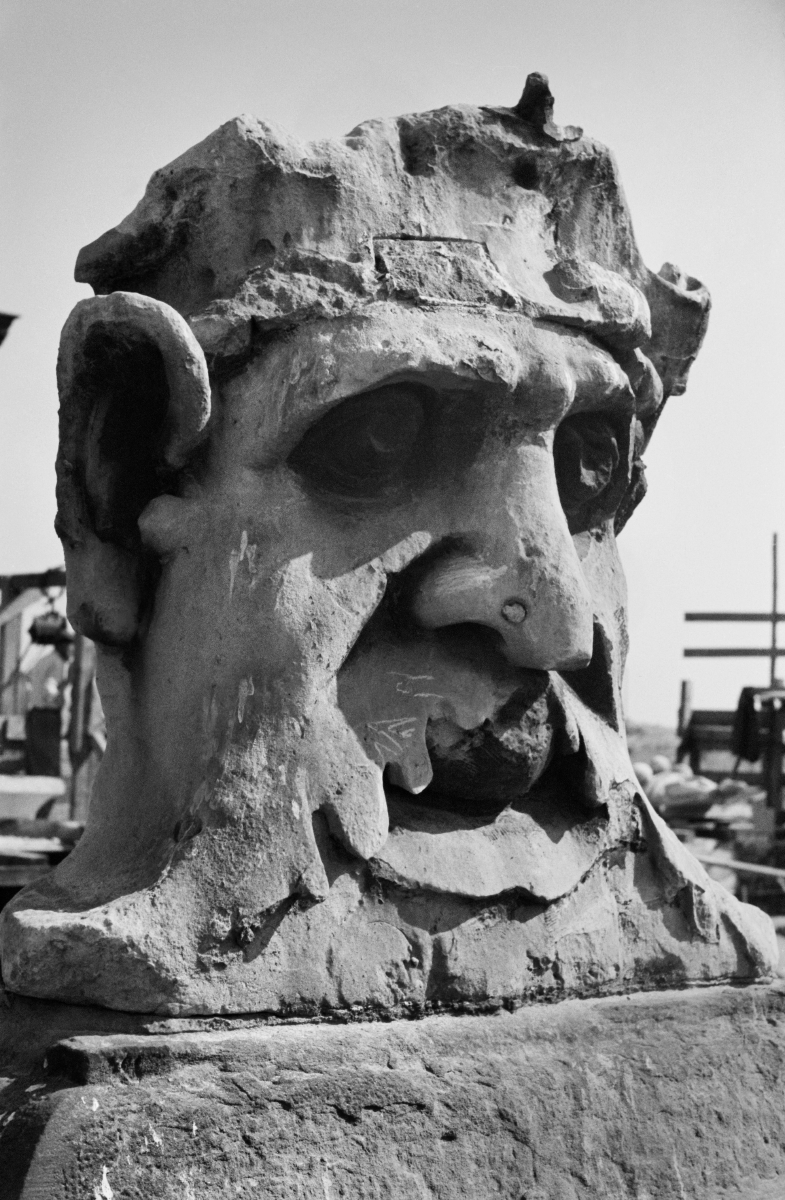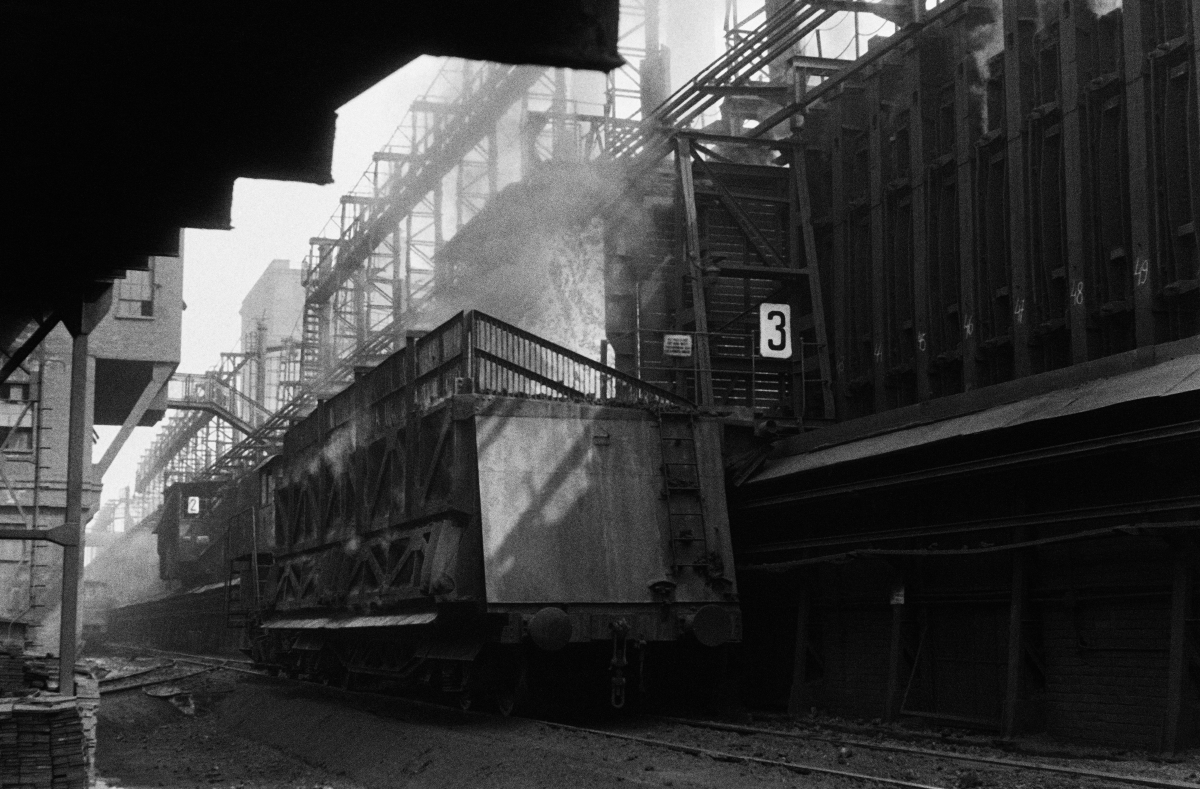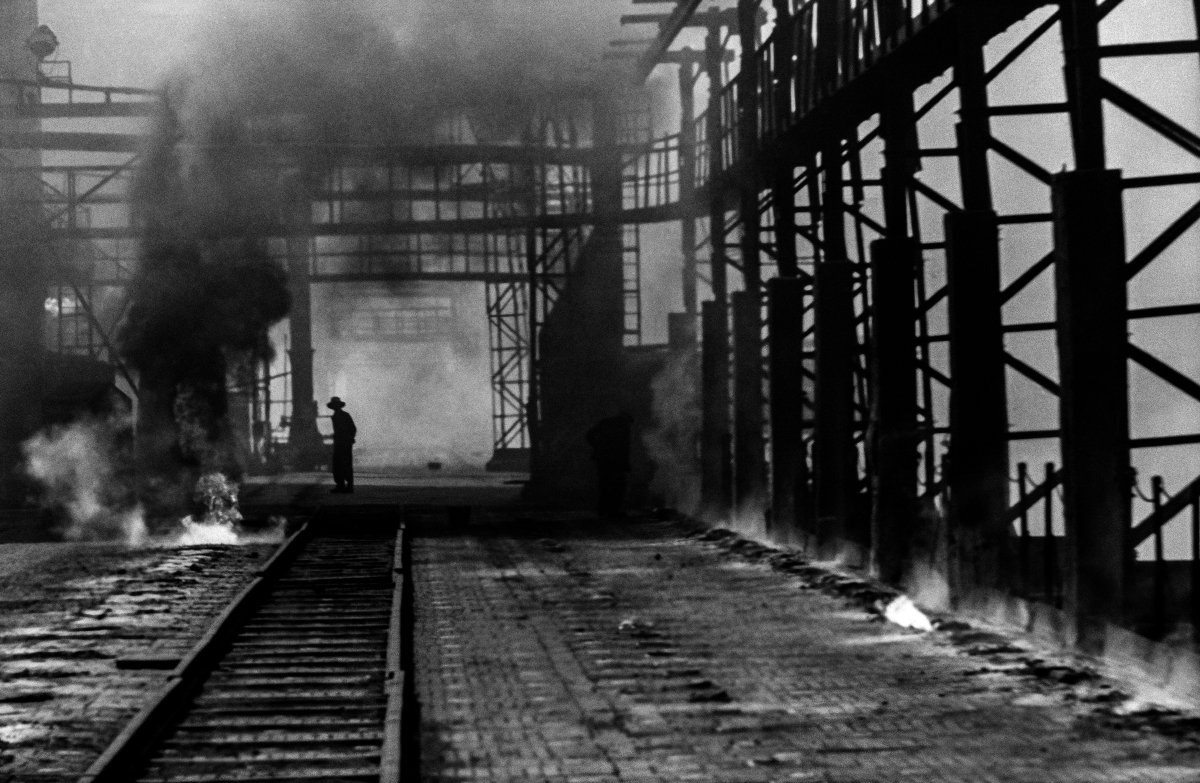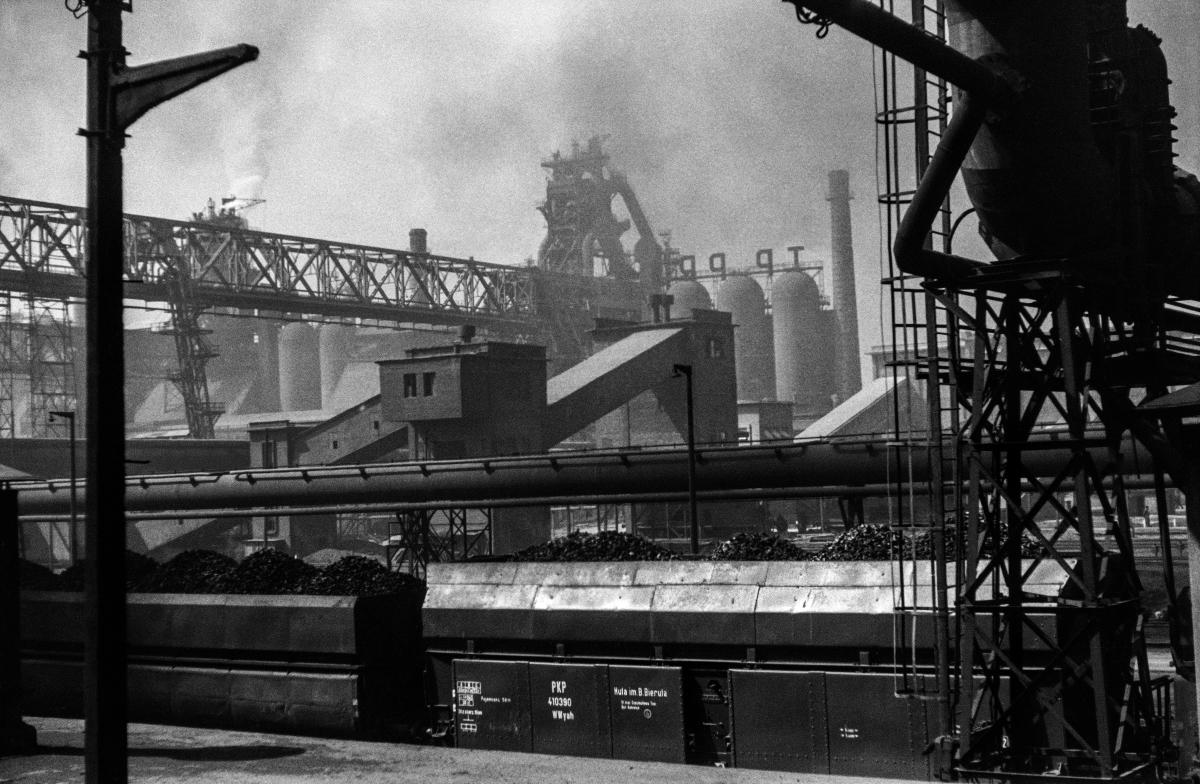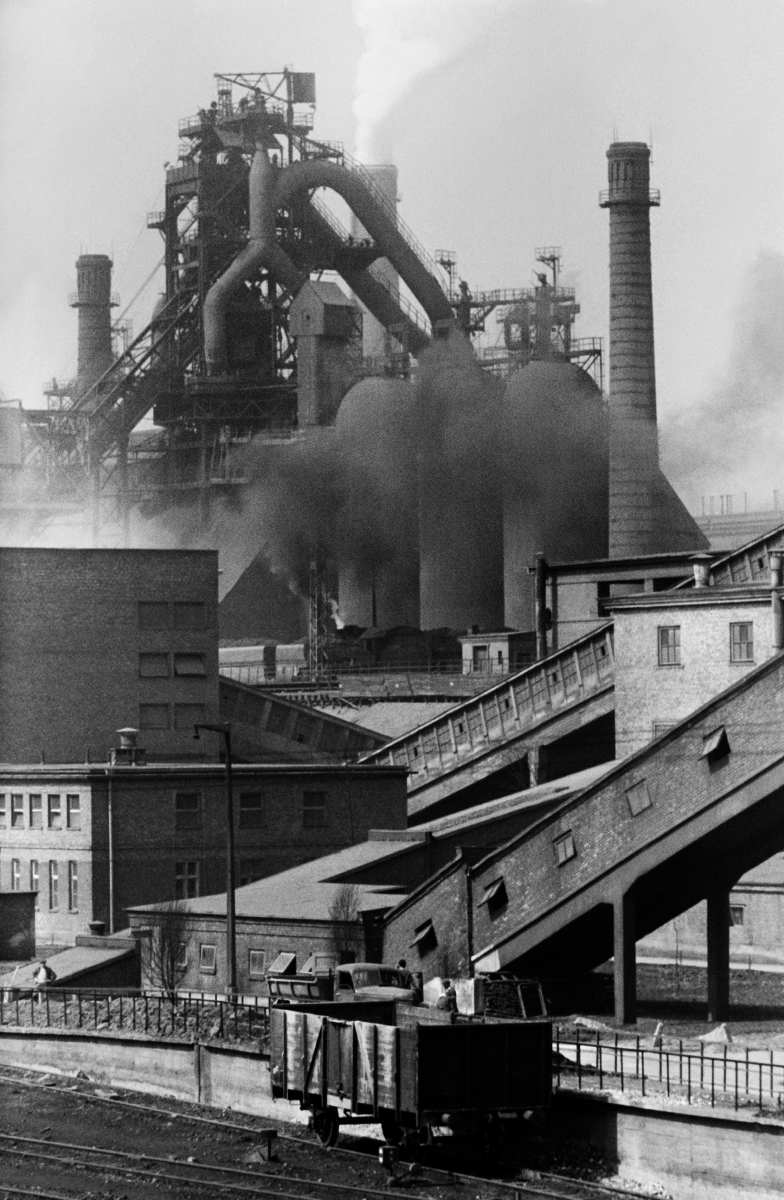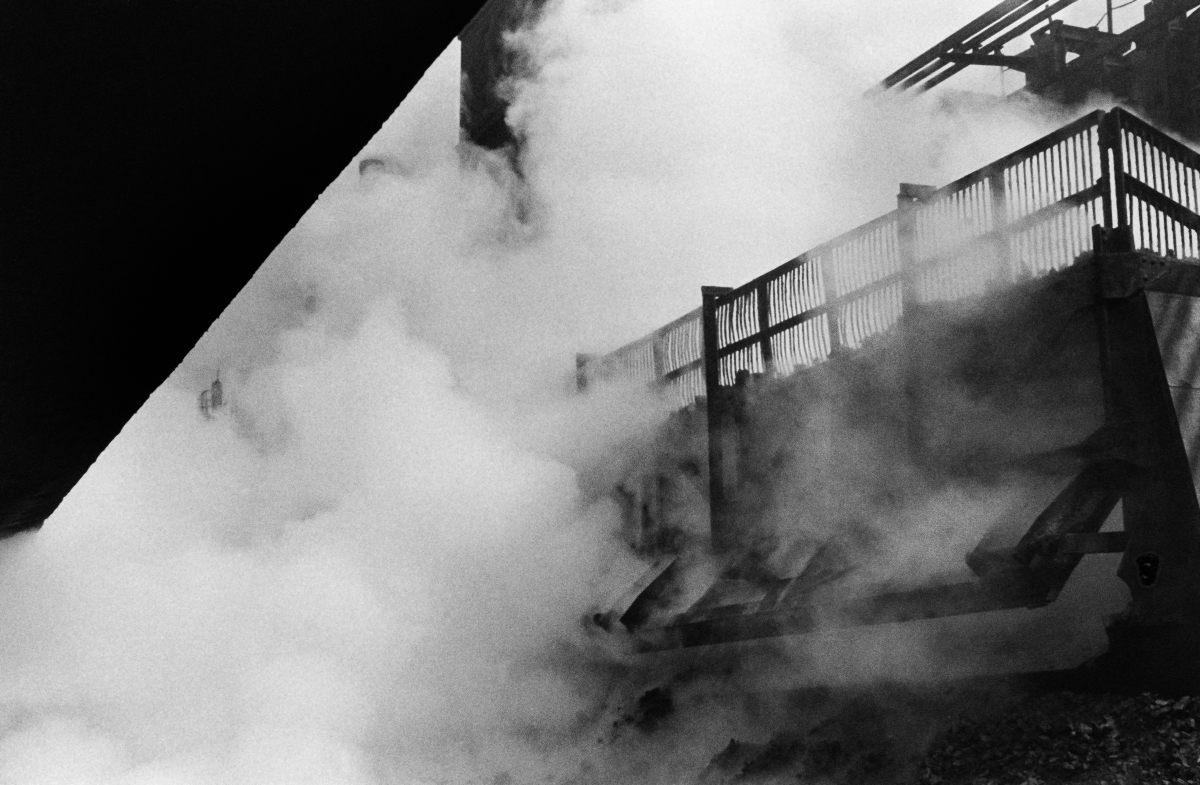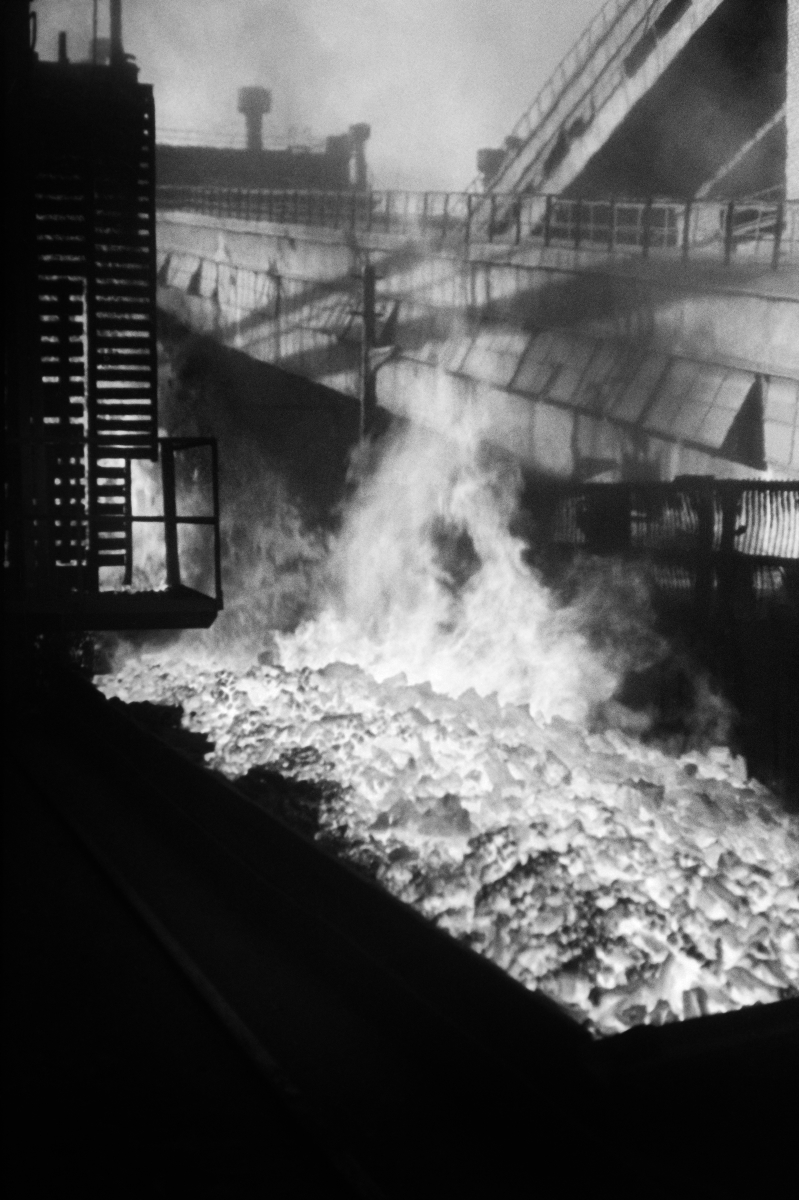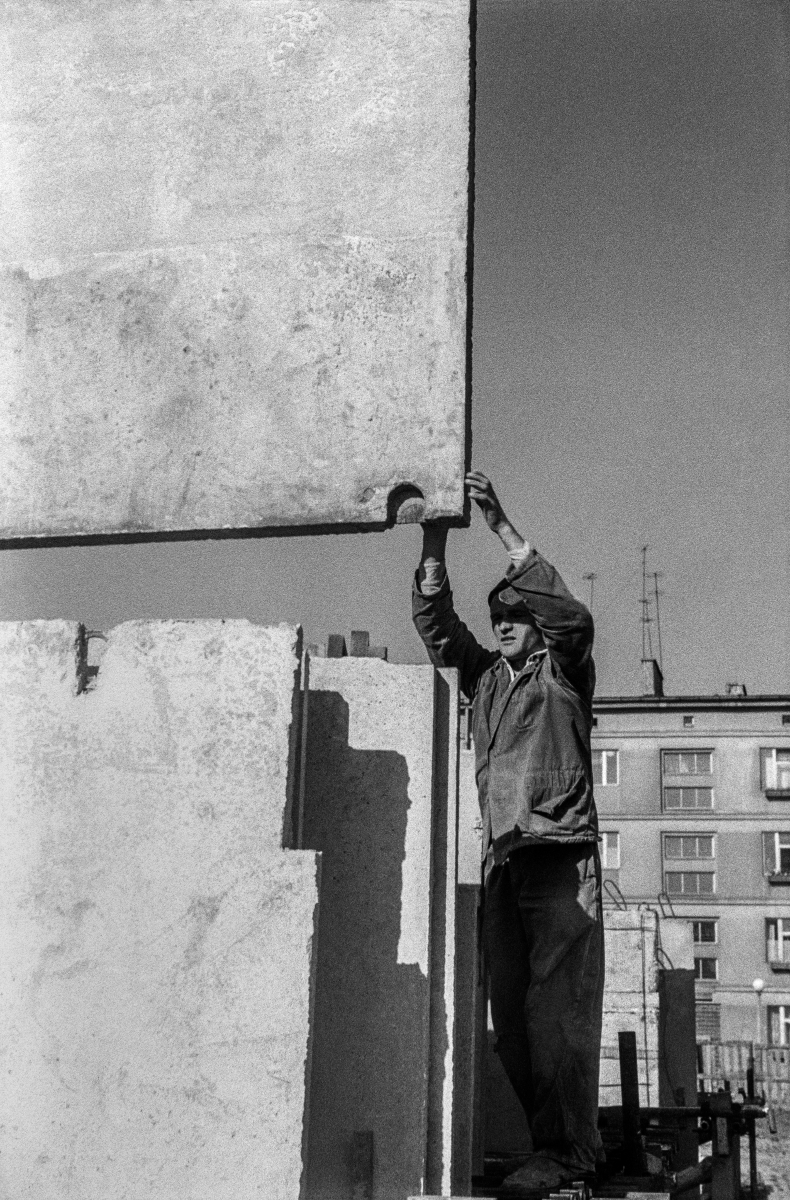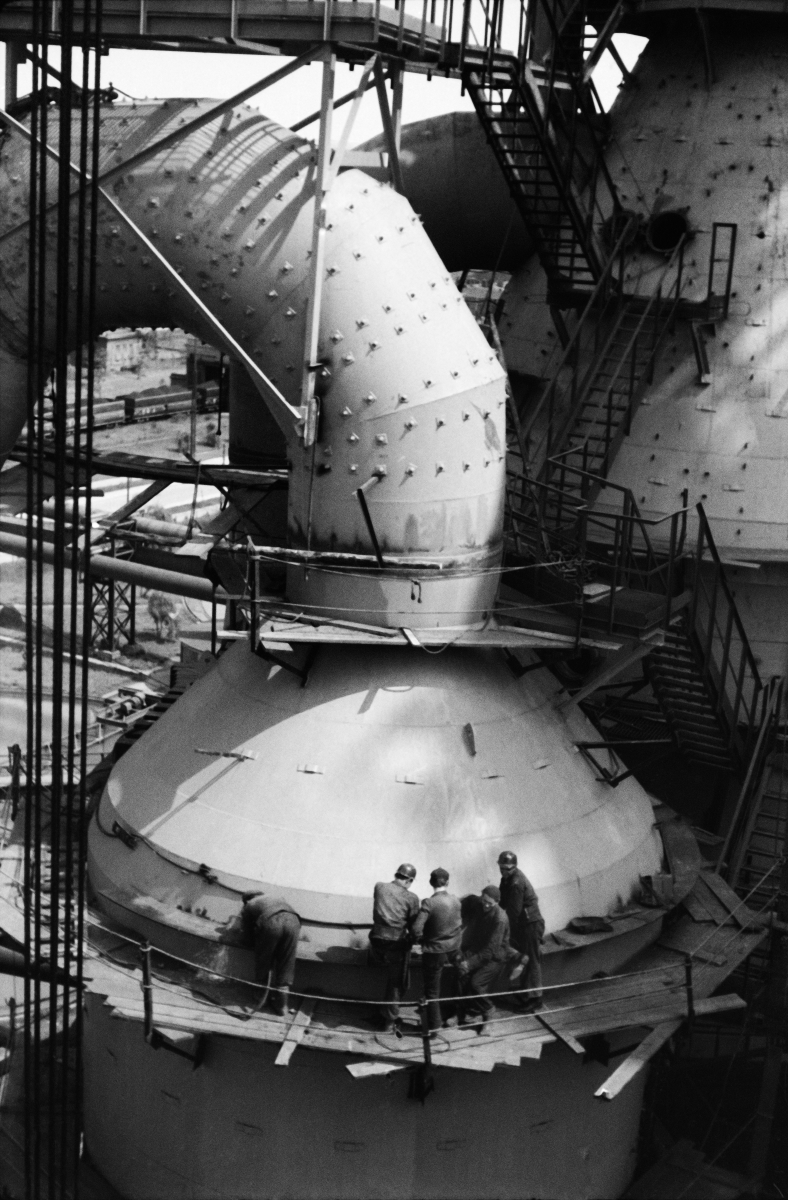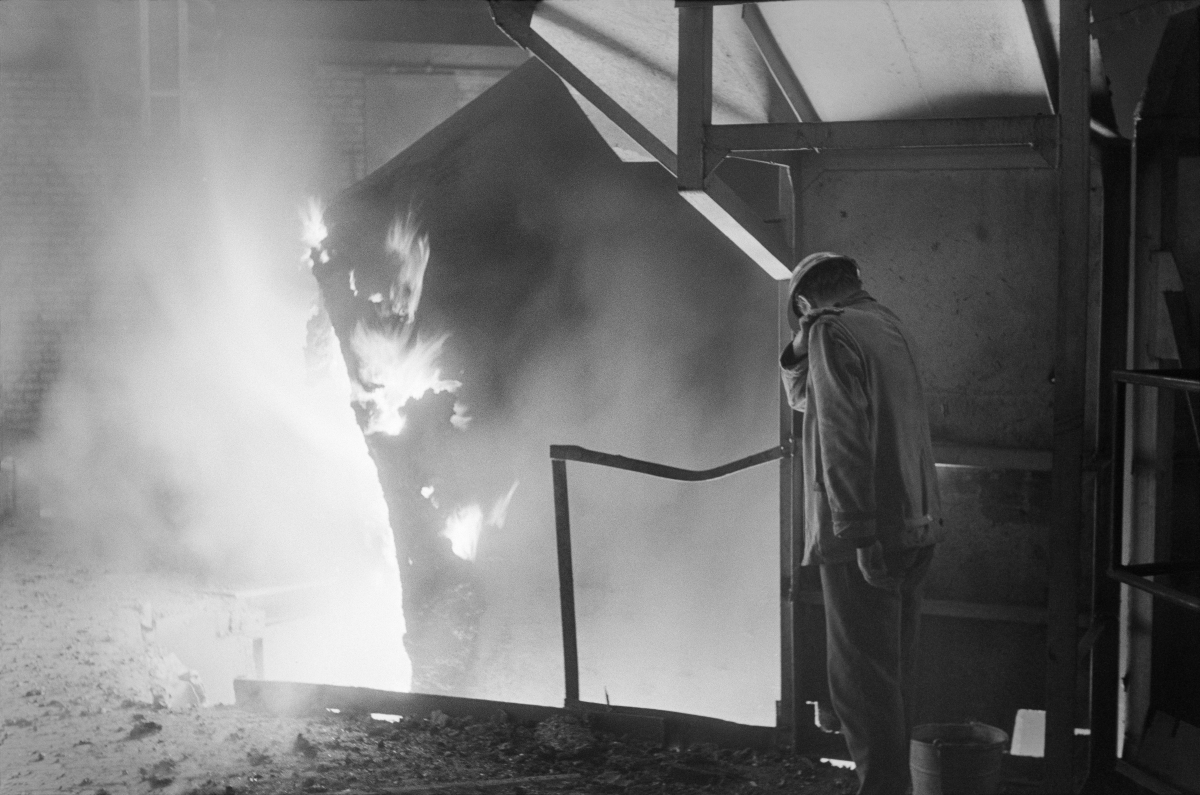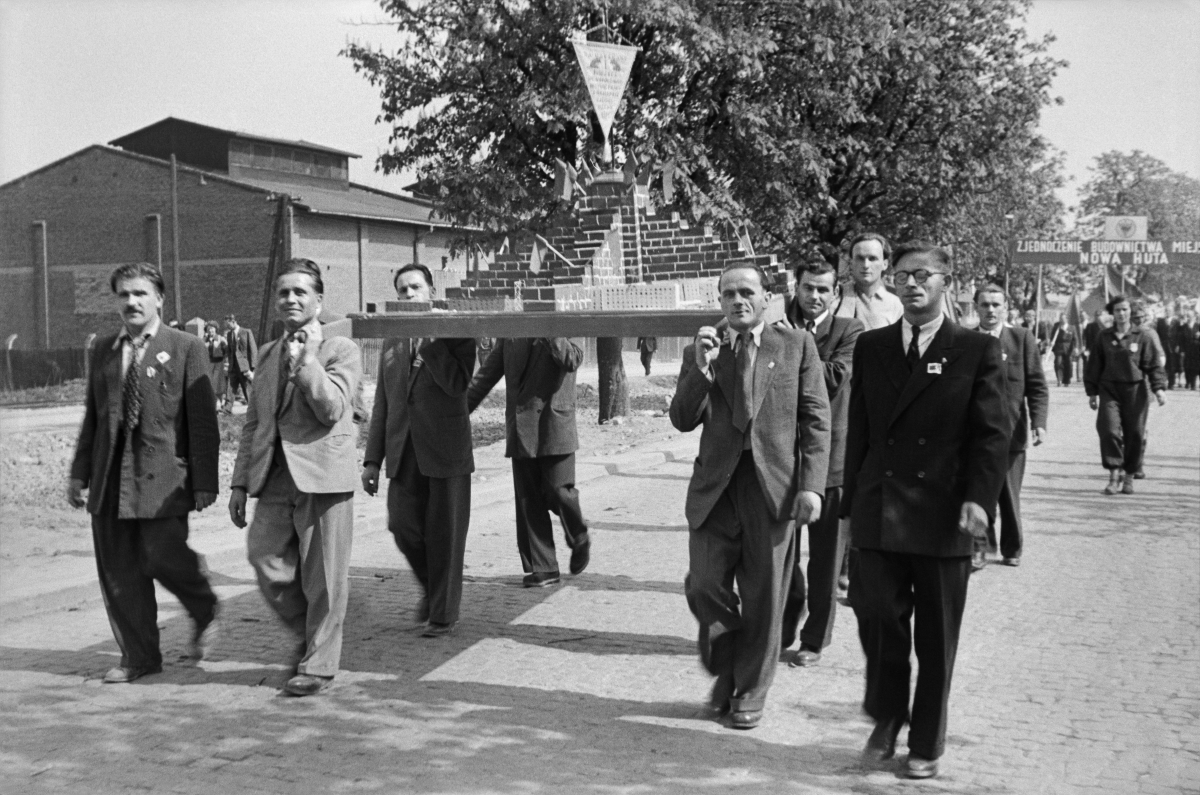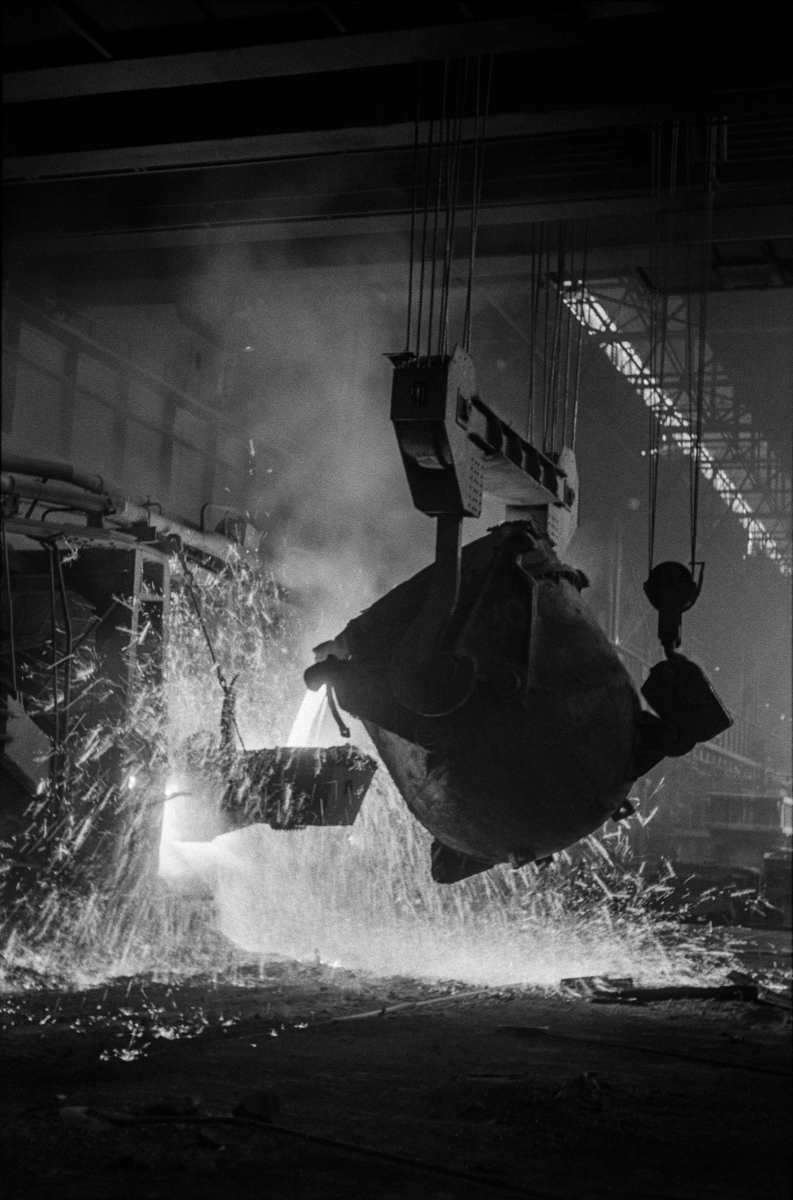BRAND NEW KOMBINAT.PL
BRAND NEW NOWA HUTA
Dorota Jędruch (history of art & other histories) , Rafał Woś (economy)
Immaculately laid paving setts reverberated the rhythm of Director’s frisky stride. Lights were already coming on in some windows, and were still on in others, having never gone out. Day was breaking.
A city should be regarded at dawn. At this time of day, the contours of buildings seem particularly well defined, vigorously highlighting their own darkish bulks. Sleepy eyes may rove round the whole picture, or they may act like a camera zooming in on a detail of a remarkable character. The morning chilliness and dampness, the first cup of coffee and the first cig, the slowly receding drowsiness sharpen the senses, causing the eyes to take a more attentive, unhurried look at things. Empty streets, streetlights being switched off, imposing buildings.
The first trams and a few solitary passers-by could not disturb the intriguing view of the cityscape right now. They provided a subtle touch to the ubiquitous arcades and columns, they were like the trains and figures in de Chirico’s paintings. Standing in the middle of Edward Abramowski Central Square Director hesitated for a short moment. He directed his glance towards the huge architectural model of the town hall. In the rising sun the wooden construction hidden under a canvas cover could be mistaken for the soaring building that was to replace it in just over a year’s time. Work on its alternative, technical aspects was well under way at Kombinat.PL. The craze for finishing and reproducing history, going on from the 1980s, remained completely incomprehensible to Director. In the four corners of the world most bizarre architectural ideas from the past, ideal cities, architectural utopias, impossible buildings, eerie dreams of visionaries long gone were being achieved with immense enthusiasm. In a world where economy was dependent on the construction of cities, people desired more and more architecture, their thirst for sculptures, installations, paintings, and design seemed unquenchable. Goods were purchased on a massive scale – beautiful fabrics, impeccable pieces of furniture – durable and of superior quality. Junk plastic products from the end of the previous century were a thing of the past, what mattered now was the quality of materials and, above all, the quality of design.
Bored stiff of the pragmatism of buildings that always had to serve some pre-established functions, the public relished the consumption of dreams of the impossible: levitating constructions, never-ending phantom projections, and – most of all – completion of vast urban developments of the past. Kombinat.PL, the Nowa Huta-based architectural and construction giant, specialised, amongst others, in this sort of enterprise; they designed and raised futurist cities, spreading cities, linear cities, plug-in cities, commissioned by public institutions and private companies worldwide. It seemed obvious that the will of 1950s designers should be obeyed exactly where the corporation was, in the unfinished social realist ideal city of Nowa Huta. For the 2000 Summer Olympics, sports facilities were put up just as they had been planned back then, including the state-of-the-art stadium with a seating capacity for 200,000 people; the recreational area surrounding the Nowa Huta Reservoir was thus expanded. Old designs by Zbigniew Solawa were used as a basis for the erection of a rather unique church in the Teatralne Estate. Lofty, expressive towers of the building designed in the 1970s by Tadao Ando proved a perfect fit for the conference centre frequented by specialists in aesthetics from all over the world, who regularly attended the congresses staged in this extraordinary temple of beauty. Not far from Town Hall Square, the Orbis Hotel was put up; its suggestive mass was created by Oskar Niemeyer himself in the 1950s.
Planned to close Central Square, what was once to be a theatre and a cultural centre now housed the Main Centre of Creativity and Normalisation of Aesthetic Solutions. It was a research unit, investigating the perception of art and aesthetic experience to develop innovative visual concepts for new cities. Clearly inspired by social realist architecture, the building was an environment-friendly and energy-efficient construction with walls covered by a lush meadow of poppies, cornflowers, daisies, and wild grasses, for the best part of the year. Tangling around architectural details, luxuriant plants marked the silhouette of the social realist prototype, a cubic building with a portico supported by Doric columns, and a dome.
It was decided at a designing workshop for residents that the building should provide a connection between two histories of Nowa Huta – the legacy of social realism in the classical spirit and the environmental legacy of the old rural area. Its roof had been adapted to serve as a huge playground, while the transparent dome made it possible for playing kids to look inside. Innumerable children, teenagers, adults, and elderly people from all over the world were swarming inside. Most visitors were equipped with sophisticated measuring devices, some were wearing funny helmets and gigantic glasses, others had diverse monitors attached to their legs or wrists. The gadgets were not hampering them in any way, so they could devote their – rapt or scant – attention, some immobilised by awe, some dancing, walking, or exercising, to great works of art purchased for the Centre in major museums round the globe. The Centre laid down normative guidelines for the aesthetic industry. A substantial part of the research conducted at the Centre involved developing archetypal models for humanity as a whole, which would, in time, help generate universal aesthetic prototypes for mass productions. Psychoanalytic problems and Edward Abramowski’s deliberations served as an important focus, too. In the modern, democratic society that sought egalitarianism ideas of the philosopher who had believed that aesthetic experience constituted an instrument of the liberation of classes and individual freedom were vastly popular.
Director was looking with delight at the experimental establishment where people were taking up the challenge of coping with the unchallengeable – the desire of beauty, the power of taste, the meaning of symbol, the force of experience, social and individual reception. Yet he did not wish to get carried away by visionariness. Exploration of aesthetic needs only complicated the image of the human being, rather than simplifying it. The more people found out about the experience of art, the more complex the phenomenon appeared, escaping simple formulas.
It was for this reason that Director approached the newest idea that kept exciting the residents of the city – putting up a huge social realist town hall at the end of the Avenue of Roses – with obvious reserve. He realised all too well that the required consensus to be reached in the unavoidable debate about this matter will not be easy to achieve. On top of that, all the plans and models from the 1950s featured a Renaissance-style building. Ugh – cringed Director. He had always had an aversion to the Renaissance, scoring 3 out of 10 points on Abramowski’s scale assessing reaction to the style. A simple socle, a rhythmical colonnade, an ineluctable attic, and a two-storey tower divided by protruding lesenes above. An onion-like helmet and a lighthouse. The Town Hall was not different from the multitude of Renaissance town halls found in KOMBINAT.PL brochures, offering designs for mass production. The Renaissance attic was among the most popular choices for the top of a building, but it brought cliché and banality to mind, correctness and dullness. This sort of attic was mostly observed in cheap residential constructions, or in pavilions set up on allotments. There was also the 1950s version, more dynamic and with a peculiar Renaissance-style loggia on the second floor of the tower, à la the Town Hall in Poznań, but Director thought it equally boring and predictable.
The general meeting of delegate councils was scheduled for that evening. Director was afraid that there would be more arguments quoting tectonics, proportions and dispositions, invariably presented to support schematic projects. There would be a lot of talking about the language of architecture, universality and classical solutions. He believed that the compulsory course in the history of architecture taught from primary school surely contributed to extending knowledge and promoting aesthetic awareness, but it was also accountable for advancing banality. After all, exams at schools only tested what could be tested, ideas, definitions, schematically outlined theories. Rationalist argumentation, argumentation related to spiritual needs, the Baroque, regional character, functionality, organic nature, abstract art, conceptual art – kids knew relevant formulas, but were they still capable of seeing things unrestricted by internalised structures? He sometimes felt that art history gradually killed art, intuitive and uninhibited. Surely, art historians had a better understanding of art than of artists.
Director often wondered if the excess of knowledge was not inconsistent with Abramowski’s belief that aesthetic sensations occurred beyond the intellect, that they should be an expression of intuition, evoking memories of “some forgotten real objects which make the effort to be remembered by creating their own domains of aesthetic life in the internal experience of a person,” as the philosopher wrote.
Director lit up a cigarette and proceeded to his office at the Centre. He was stopped, for a moment, by Abramowski’s crazed gaze in a portrait by Vasarely. Adorning the Centre’s facade, the portrait made after a mug shot kept in French police records always bemused him. You wrote so much about the impact art should exert, but you forgot to leave a single hint at what it should look like… thought Director, looking at the well-beloved philosopher.
– Good morning, Director, it’s an interesting presentation we’re going to see today – the doorkeeper greeted him. – This Palladian bullshit sounds like gibberish to me. Don’t we have enough of that? And the totalitarian version, too. Outdated. As usual, the national conservative faction will defend the attic. In the 50s, the Soviets put those attics just everywhere. That didn’t pay off, did it?
– Good morning, Kazimierz, – Director went through the entrance hall, entered his office, and sat down behind a large desk that used to belong to the first director of the Combine. On the walls, there were beautiful photos showing the first years of Nowa Huta. Emptiness, wonderful emptiness… – Director thought. Those cities had breathed. Even if that was cold and unsettling breathing down your neck, still… he hesitated. Longitudinal lines of streets, green squares, pavements, formed great carpets, and penetrated deep into the picture. Unplastered buildings seemed like elements of the background, a closure of this airy composition. Vast and stony empty spaces extracted from age-old fields and meadows never fully yielded to architecture, even if it was architecture that gave rise to them. The passers-by in the photographs – the first users of the city – seemed strangely excited as though everything there was new and puzzling. Always on the go, quite bashful, they appeared to be learning the city that kept appearing in front of them like consecutive stages of a computer game. There was always exactly the right number of people in the street for the photographs to be good. Never too many. This place always looked good in photographs.
Director had seen similar cities before – vast, monumental, social realist developments. Interestingly enough, it was the uniformly black streets that were accountable for the aesthetic aspect of those places, rather than monumental architectural complexes. People’s perspective was determined by that blackness. An empty, wide roadway had always been the best observation point, and the painted lines on it had determined the axes of symmetry. The cracked and faded asphalt of Magnitogorsk merged with the grey and contaminated skies to form a single scene accommodating regularly spaced urban props. Smelting products, and there was still market for them, continued the production model long abandoned in Nowa Huta which was predominantly creative in spirit and dominated by aesthetic industry.
One of the photos in Director’s study depicted a mass demonstration. Participants were carrying images of Stalin, Bierut, and Lenin. It seemed like an ordinary march full of enthusiasm, a sort of landmark of the era. But one had to keep in mind that they were all recovering from the war. From hunger, fire, and death. At every corner, individual and collective, industrial. Some of the people marching with portraits of villains in their hands were merry and passionate, others morose, tired, grey. Something was wrong here, though… Suddenly a similar scene appeared before Director’s eyes, the same section of a crowd but people were driven towards a ramp, expelled from their houses, uprooted. These people had been there, people like them. Where had they taken these strength and hope from? This was somehow implausible, unconvincing. This construction site upon ruins. What was the difference between heaps of bricks waiting to be used in a new city and charred remains of the destroyed city of Warsaw? People amidst ruins – of what was coming to be, of what had been annihilated. As though someone had played a film backwards. Everyone’s happy today, Director thought bitterly, chasing away the sentence which emerged unexpected from nowhere.
Evaluation of the post-war days, as seen by contemporary economists and a substantial part of the society, was far from obvious. The atrocities of the Stalin era and the imperialism of the Brezhnev era were naturally condemned, but it was generally recognised that without the Soviet experiment poor economies in the Eastern Europe would be forever reduced to be subcontractors and reservoirs of cheap labour for countries in which capitalism flourished. Imposed upon Poland in 1945, socialism had luckily managed to evolve in the years that came into a system accepted by a majority of the society of free comrades and citizens. The crucial date was 1980, and the formation of the mass movement known as Solidarity. This popular spurt united resistance against the authoritarianism of the Polish United Workers’ Party PZPR, its fossilisation, its abandonment of leftist ideas, and the excessive interference from Moscow. The talks held at so-called ‘round table’ resulted in the first free election which took place on 13th December 1981. The Government of National Unity was formed, led by social democrat Karol Modzelewski, a member of Solidarity. After the 1985 election, various political groups came to power representing consecutive generations of politicians which reflected social transformations in Poland. The biggest of them included the Social Justice Movement and the Conservative Union. Aside from the parliament, political life was active as well, with a range of thriving political movements: trade unions, workers’ councils, religious associations, intelligentsia clubs, and anarchist collectives.
This was why the hundredth anniversary of the Revolution had been joyously celebrated in Russia in the previous year: one hundred giant cakes in the shape of the Palace of Culture in Warsaw were baked in a number of cities, and later consumed by their jolly inhabitants. This year, preparations were being made for celebration of the anniversary of the regaining of independence in 1918.
Possibly, no-one was absolutely satisfied with this state of affairs, suffice it to say that it generated a sort of unsteady balance.
Things looked very much the same in regard to the aesthetic policy. The lack of one social project, one model, and one truth, led to the rejection of a homogenous and holistic project, and to a polyphony of aesthetic attitudes. Accepted models included the monumental history-oriented one as well as the cosmopolitan one, universalising the classical style, and the abstract modernist model. Discussions of art tended to focus on the act of perception, rather than the work that was perceived. Effort was taken to develop projects that would appeal to the masses, the focal point of collective sentiment. Neither kitsch nor excessive sophistication was avoided. No time was wasted for wondering if the purpose of art was to provide mass entertainment or inspire individual relish, or the other way round… Art was to be around and arouse emotions as complex as human sensitivity and imagination.
Liberating the individual from daily troubles and hard toil, social changes made contemplation available to everyone. As a matter of fact, the only people working really hard were now architects, designers, and artists. Many parents tried to hide their children’s artistic talent, knowing that the admired profession of artist involved in fact hard creative labour. In vain. The system of public education was finely tuned to singling out gifted individuals and obligatorily training them for an artistic career. In small, closed communities of the future there was only place for one style and one type of sensibility, Director thought dreamily. But in a global world of aesthetic mass industry what remained was free, totally unrestricted choice.
The sound of an ambulance interrupted Directors thoughts. He heard a knock at the door. Someone got an aesthetic shock at the Gallery of Modern Architecture, an educator told him. That was hardly an isolated incident – in one of those experimental concrete chambers with beautiful proportions into which light oozed gently through abstract stained-glass. Lonely contemplation in a place without narration, abstract and affecting all senses could prove too intense for inexperienced viewers. Terrific – the educator was contented – I have an entire chart of the emotion curve, separate for each sense! I’m off to prepare the debate, he shouted rushing out of the office.
Around 5 pm delegates from aesthetic councils by the local government, various workplaces, and non-governmental organisations started to gather at the Centre. Each of them was supposed to disclose the decision reached by their unit about which variant of the project they preferred. As usual, the event attracted a great deal of media and public attention. Newspapers presented the projects, the streets were buzzing with excitement, critical essays mushroomed and so did satirical shows, inspired by the contest. Groups associated with the Conservative Union, the so-called blimpish wing, advocated the monumental solution – a stone behemoth, a truthful copy of the social realist project. Short and not exactly heated discussions on the stylistic legacy of Stalinism gave way to the belief that national values and the symbolic message conveyed by the building are more important than historical occurrences. A team of architects collaborating with the Union had even taken a trip around Polish historical towns, hoping to find some stimulating examples and ornaments. It had been utterly pointless because KOMBINAT.PL offered a complete set of patterns, collected over the years in the research they conducted on Polish building tradition. Anyway, every nursery and primary school arranged obligatory excursions to historical places. But in terms of propaganda the outing was priceless. Television viewers watched the consecutive stages of these artistic peregrinations of prominent rightwing politicians with bated breath, combined with lectures on the history of art, exercises in describing and analysing artworks broadcast live by TV (that was a lot of fun), and survival tasks that the conservative politicians in their immaculate suits were faced with during the show.
The Social Justice Movement suggested something different. A glass modernist building that only broadly reminded the town hall designed in the 1950s. The crystal construction got narrower as it got taller, and it was crowned with a steeple. It would turn round – the lower part would make one turn in a year, the middle part – in a month, and the upper one – one rotation per day. The project was considered megalomaniacal and widely criticised: “Żeromskian”, “satanist”, “occult”, “platitudinal constructivist cosmopolitism!” – shouted a crowd of fans of the monumental social realist version in front of the Movement’s headquarters. A real battle between marble and crystal was about to take place! The purpose of the building also stirred up controversy and emotions. Details like these were, of course, discussed aside from the main debate, as is always the case. The discussion revolved around the symbolic position of the building in the urban fabric, the social effects it would produce, not a matter as changeable as its function. But this time even the function inspired a wide range of opinions. A monument, a temple of national memory – some people claimed, others called it the Delegate Council Palace, yet others – a complex of cheap apartments. Nowa Huta autonomists naturally suggested that it should be the seat of municipal authorities. Enthusiasts of grassroots activities propounded constructing a giant, collective hive, millions of cells for small social initiatives. But what if there was nothing in the building, or something absurd? – members of the art collective Uninhibited inquired. That would be the best symbol of economy based on reproducing historical orders and the economy of concrete.
Social tension hit its zenith that day. A capacity crowd assembled in front of the centre. Some were chanting “Venustas, firmitas, utilitas,” while others “less is more.” Guards had to intervene on several occasions, separating opponents exchanging blows. Some received instant art therapy in the Polish 19th-Century Landscape Room, as a means to stop the crowds going on a rampage. In the early evening, the situation seemed to have been brought under control. Demonstrators had dispersed. The vote was schedule for the next day. Until then aesthetic silence had to be maintained. No opinions on art could be publically aired, all museums and cultural institutions were to be closed.
At daybreak, Director was woken by a deafening sound of detonation. A moment later the phone rang. It was not an ordinary telephone. The piercing sound came from a secret device used by Director to communicate directly with the management of Kombinat.PL. The authoritative voice of Miranda Hansen, the chairperson, left no doubt as to the fact that something serious had happened. He was expected at the Doge’s Palace in the Nowa Huta Combine without delay. He dashed out and managed to jump onto the tram going to the plant.
The PL Combine was one of the few private firms still active in the system of socialised economy and public enterprises, as well as one of the main sources of financing the aesthetic policy of the state. It was one of the five biggest corporations in the world. It developed on the foundation of the Lenin Steelworks in Kraków. “PL” was an abbreviation for the official name Przemysł Ludowy (People’s Industry), which was soon shortened turning into a hallmark.
PL was active in heavy industry until the end of the 1970s. Then it gradually evolved into a combine expanding and introducing foreign licences bought in Gierek’s times. Apart from that, they were carrying out experiments to design inventions rooted in Polish scientific research and innovativeness. As a result, Poland escaped the trap of premature deindustrialisation numerous countries in the so-called Second World stumbled into.
PL conducted tests in the field of information technology and pharmaceutical manufacturing (the hugely popular painkiller Adoloran). The breakthrough came with the realisation (in the late 1980s) that the real future of the world would take place in cities, which, in today’s globalised world, seems perfectly obvious. PL began to build cities. Literally, at first. From ready products to their assembling into metropolises. The social realist Nowa Huta – a successful combination of socially, communicationally and ecologically coherent city fit for the 21st century – provided a model. It was popularised by the breakthrough “Słodowy1” technology, also known as “do it yourself.” The less known Swedish furniture manufacturer Ikea was also trying to implement the idea. It had remained the core of “Polish economic miracle.”
Prefabricated materials were soon followed by programming cities. Invented solutions were mostly of the smart city type, for instance the quiet, low-emission public transport and collective urban planning meant to prevent increases in social inequality. These initiatives helped almost entirely eliminate private cars from Nowa Huta. With deep relief, residents waved goodbye to the smog which had been suffocating them for years, and became accustomed to travelling by electric trams and free taxis.
Nowadays, PL was also working on how to make artificial intelligence provide efficient service to the whole community (the pioneering Ewa1project), rather than to a chosen few. It was also developing designs for cities that would be constructible in space (the Twardowski1 project).
Miranda was looking through the window at the partially emptied premises of the former Lenin Steelworks. It was only the bird’s eye view that allowed one to see its vastness. The desert of the old excavation, railways, pipelines, conveyors suddenly breaking off in the air – a moonscape of abandoned production schemes offered stark contrast to the ordered urban area in the middle of the nearby city. Madam President liked the rough and surreal atmosphere of such places. Many former plants had been vacated. Kombinat.PL organised regular tours around the sector, converted into a technology park, not only to convey the aura or to keep pace with the fashion for industrial architecture. Jutting stumps of fantastic ferroconcrete structures were viewed by school kids as curiously as ancient ruins. Light oozed into the gigantic halls that used to be rolling or steel mills, now serving the function of design studios, like in Gothic cathedrals.
Madam President found immense pleasure in watching photographs taken in the 1950s, depicting labour in the Combine in its early days. Miranda would sometimes imagine steelworkers’ tensed muscles, hidden under the carapaces of asbestos tows. In her modernist avant-garde villa she had a large collection of social realist sculptures of model workers from the Stalin era. She enjoyed looking at their athletic bodies positioned by her swimming pool. One of the torsos adorned her bedroom. These bodies stood in strong contrast to the pictures of Combine workers. Ordinary people, shaved, with neatly combed hair and strikingly real faces, posed for photographs. There was tension in these images, between the myth of superhumans of the new reality and the fact that they were hard-working simple guys, wounded by history, hoping for a better life in a new city.
Black-and-white photographs created the impression of having been overexposed because of the glowing white of pig iron streaming into giant vats. Miranda felt as though the old negative had been burning her hands like red-hot iron the steelworkers never parted with in the Combine. She fully realised that the protective clothing they wore, farmer style hats and glasses, must have given little protection against the oppressively hot raging element. She knew that the image of men subordinating nature to themselves, shaping primeval matter according to their wishes, to the dictates of the superhuman power of human arms and muscles, was nothing but an industrial myth of the first capitalism. Tiny steelworkers’ figures, hardly sheltered from searing heat, which she saw in the pictures demonstrated much more the frailty of human bodies in the world governed by the law of the strongest. Sick, exhausted, worn-out people had sometimes to pay a very high price for this secretive performance in the grand narrative of the industrial era. Miranda felt a frisson of excitement. The stringent rules of the world of labour, physical exertion, heavy industry never ceased to thrill her, even though the company she was the head of relied on intellectual capital rather than herculean effort of industry heroes.
Director found Miranda in a funny mood. She seemed both upset and dreamy. Madam President seldom allowed such honesty on her face. Indeed, she got straight to the point.
– Do you know someone sabotaged the hall town project last night? They blew up the model of the building.
– Do they know who did it?
– Yes, he was caught red-handed. One of those primitivists from Pustostan. The unruly group of artists refusing to work for the system. But from what he’s said so far, his motives weren’t of the aesthetic kind…
– Shocking, Director was truly worried? Or…
– Or another action aimed directly at our projects. We’ve not had such problems since the notorious attempt at blowing up Lenin’s monument.
– Is a total ban on building what they want?
– Yes, and they won’t take the final exam in art history. Strange. It’s been a while since we last had public protests. People lead quiet lives in modern cities, they buy products of the highest quality, perfectly designed. They take part in the decision-making process. There are no serious inequalities on a global scale. I can understand protests staged by artists, they work extremely hard – not enough time to design and create. The demand for their work is huge. But there hasn’t been a political protest in years. The culprit is undergoing art therapy but there’s a fair chance that he won’t be persuaded art is a prerequisite for economic and aesthetic wealth. He keeps quoting Shakespeare and talking about the beauty of nature. Are we supposed to live in clay huts? We have tried to implement the Walden project, initiating production of individual forest cottages, but it failed to achieve massive popularity. We’d like to put our idea of building an estate in the Białowieża Forest into practice soon. This vast and attractive area hasn’t been made available for real estate development yet. I’m afraid such protests make public opinion turn against the project. And we wouldn’t like to suppress democracy. It’s been working rather well so far since people feel their voices matter.
– Alright, if you don’t mind we’ll examine the primitivist at our Centre. Shall we now take a look at your new plans?
– You mean the Twardowski project? The town on the moon? We’re currently testing residents’ subconscious ideas of the perfect home.
Miranda and Director went to one of the huge design studios. A 3D printer kept generating successive elements of a giant model placed in the middle of a big rolling mill. The machine was releasing more and more colourful pieces that looked like toy building bricks. In the small rooms there were several hundred people from all over the globe, some sleeping, other viewing works of art, listening to music, and yet others (which was the Combine’s trade secret) were exposed to the effects of hallucinogenic substances. Their brain activity was registered, they were asked to describe and visualise the content of their dreams. All this was then rendered into the language of architectural components.
– As you can see, we’re a step or two ahead of your Centre. The truth is that a universal beauty code is present in the deepest layers of the unconscious. If we learn how to decipher it, the whole market of aesthetic needs is ours.
Miranda laughed with that menacing laughter of a mad person, suggesting insane designs for assuming control over the world.
– Well, it looks like an enlarged Lego town, Director smiled. Do you intend to add something historical? Some Baroque quotations perhaps, he thought nostalgically.
– Yes, very much so. Statistically, every tenth person has thoughts of the colonnade in St. Peter’s Square. So we’re going to put some sort of colonnades there, an obelisk, and a building with a dome. That’s what you can see in all cities. Domes are absolute bestsellers. Towers and domes, everybody wants them in the centre. Under the dome we’d make a giant hot house, an orangery. There’s not much of it on the moon.
On leaving Miranda, Director took a long walk around the Combine. He observed parts of various buildings – prefabricated bases and shafts of columns, Gothic pinnacles – loaded onto modern electric trains. Doric columns made of PVC to be used with campers or to support multifamily tourist tents were a novelty. By the entrance, a young man guarded by a policeman was waiting for him. He looked trustworthy. His clothes were simple. He had a satisfied expression on his face.
– Was it you who tried to blow up the town hall model? Why would you want to do that?
– All newspapers are writing about it. What they don’t see is that we don’t give a damn about any of those hideous projects. Journalists keep asking me if I like Baroque classicism better than monumental historicism. Rubbish. Do you know where the real beauty is? It is where there’s no architecture, no pictures. No future, no picture!
Interesting, thought Director. That would be the end of our Centre. No pictures, no architecture – the end of civilisation. Director never told anyone about the dream he had every night. The great Baroque portal he had seen many a time in one of the chapels in Corpus Christi Church in Kraków. Having passed through it, Director suddenly found himself in a vast meadow. A homogenous carpet of lush grass, moving in the wind, was stretching up to the horizon. Rich cereals, flowering poppies and cornflowers appeared so real and that made him wonder. Would it be possible to reproduce all this in a picture? The overpowering smell of summer, the warm soil, the coolness of the nearby river, all that was so unpainterly, so direct… Irritated, Director chased those strange thoughts away.
– If you consent to a test of your aesthetic preferences, I’ll do my best to make sure you won’t have more trouble, he said to the man.
– You want to take me to your Centre and connect me to your funny devices? I was there once, on a school trip. The educator asked us to pain the world as we wanted it to be. I painted a great and natural forest. I got a prize – a book titled “Forest in Painting.” Nice, but I prefer a real forest. Have you heard about the Combine’s designs – an estate in the Forest? It’s secret but we’ve got our ways. We can’t let that happen. Away with architecture!
– You’re an utopian. Art is not only the foundation of our economy, it is also the foundation of individual freedom. In a work of art the individual is united with the society, Abramowski claimed so.
– It is united with the interests of the Combine. We’re living in a soap bubble. Everything is nice and designed. Everything is mediated. We demand direct sensations. A tree and not an image of a tree, a human being and not a portrait of a human being. The whole story of this mad city, this senseless destruction of nature. But it is still here.
Their conversation was interrupted by the sound of an approaching car. It was an ancient vehicle, a Voisin… – Le Corbusier posed with a similar one in front of a villa he designed. Where have they got that old machine? – that was all he had the time to think of. It only took a few seconds. Director didn’t even realise he was dragged into the car and tied up. They were driving along one of the broad walkways of Nowa Huta. An individual car was extremely rare here. But a 1920s car did not raise suspicion. Historical re-enactments were commonplace. Director did not notice that the car was now at the bank of the Vistula. Below, the famous meadows of Nowa Huta were spreading up to the horizon. The area would long have been built-up or flooded, according to original plans. A large reservoir was designed in the 1950s. But the terrain had been provoking heated debates between the city council and the Combine. All development projects failed to receive popular support. And the area was growing increasingly wild. Once in a while the so-called great mowing of the world was organised here. Children from neighbouring schools cut the grass and pulled out weeds. Efforts were made to maintain the relative aesthetic homogeneity of the place. There were plans to stage an oneiric reconstruction of one of Claude Lorraine’s pictures. A few classical, simple buildings could be erected in this misty landscape. If the river would be directed into its old bed, parades of old sailing ships could be organised. But – surprisingly – the place attracted only scant attention. Director did not realise that the driver pressed the acceleration pedal in an desperate gesture. The car and its passengers rose into the air and flew ahead, leaving the great ideal city behind.
Director clambered out of the broken car with difficulty. He was standing up to his waist in high grass. He could smell the grass, cereals, heat, forgotten childhood. The scorching sun blinded him. He remembered Abramowski’s words on aesthetic experience. That was exactly the forgotten nostalgic image from the past. But his nostalgia was not unpleasant. No, Director was strangely happy. He had the odd feeling that he had not felt beauty so intensely, with every sense, for a long time. That this beauty was simple and ordinary. He thought of the dream that kept recurring for so long.
Suddenly, there was a terrific bang. From behind the horizon, surrounded by dust and fire, the hull of a great space ship bearing the name “Twardowski” emerged. It was the first architectural mission with hundreds of designs for new estates, taking off to the moon.
Director fell down into the grass and stared long into the limitless blue skies.
